Temperature core cluster analysis
David Stappard & Jens Daniel Müller
27 November, 2023
Last updated: 2023-11-27
Checks: 7 0
Knit directory: bgc_argo_r_argodata/
This reproducible R Markdown analysis was created with workflowr (version 1.7.0). The Checks tab describes the reproducibility checks that were applied when the results were created. The Past versions tab lists the development history.
Great! Since the R Markdown file has been committed to the Git repository, you know the exact version of the code that produced these results.
Great job! The global environment was empty. Objects defined in the global environment can affect the analysis in your R Markdown file in unknown ways. For reproduciblity it’s best to always run the code in an empty environment.
The command set.seed(20211008) was run prior to running
the code in the R Markdown file. Setting a seed ensures that any results
that rely on randomness, e.g. subsampling or permutations, are
reproducible.
Great job! Recording the operating system, R version, and package versions is critical for reproducibility.
Nice! There were no cached chunks for this analysis, so you can be confident that you successfully produced the results during this run.
Great job! Using relative paths to the files within your workflowr project makes it easier to run your code on other machines.
Great! You are using Git for version control. Tracking code development and connecting the code version to the results is critical for reproducibility.
The results in this page were generated with repository version 9b1ed7c. See the Past versions tab to see a history of the changes made to the R Markdown and HTML files.
Note that you need to be careful to ensure that all relevant files for
the analysis have been committed to Git prior to generating the results
(you can use wflow_publish or
wflow_git_commit). workflowr only checks the R Markdown
file, but you know if there are other scripts or data files that it
depends on. Below is the status of the Git repository when the results
were generated:
Ignored files:
Ignored: .Rhistory
Ignored: .Rproj.user/
Ignored: output/
Unstaged changes:
Modified: analysis/extreme_compound.Rmd
Modified: analysis/extreme_pH.Rmd
Modified: analysis/extreme_temp.Rmd
Modified: analysis/extreme_temp_core.Rmd
Modified: analysis/load_argo_clim_pH_ucsd.Rmd
Modified: analysis/load_argo_clim_temp_csio.Rmd
Modified: analysis/pH_cluster_analysis.Rmd
Modified: analysis/temp_cluster_analysis.Rmd
Modified: code/start_background_job_partial.R
Note that any generated files, e.g. HTML, png, CSS, etc., are not included in this status report because it is ok for generated content to have uncommitted changes.
These are the previous versions of the repository in which changes were
made to the R Markdown
(analysis/temp_core_cluster_analysis.Rmd) and HTML
(docs/temp_core_cluster_analysis.html) files. If you’ve
configured a remote Git repository (see ?wflow_git_remote),
click on the hyperlinks in the table below to view the files as they
were in that past version.
| File | Version | Author | Date | Message |
|---|---|---|---|---|
| Rmd | 9b1ed7c | ds2n19 | 2023-11-27 | Cluster under surface extreme. |
| html | 55244e4 | ds2n19 | 2023-11-24 | Build site. |
| Rmd | a6ed1c0 | ds2n19 | 2023-11-24 | Cluster under surface extreme. |
| html | 77cc54e | ds2n19 | 2023-11-24 | Build site. |
| Rmd | b24f211 | ds2n19 | 2023-11-24 | Cluster under surface extreme. |
| Rmd | 59f5cc4 | ds2n19 | 2023-11-23 | Moved spatiotemporal analysis to use aligned profiles. |
| html | 80c16c2 | ds2n19 | 2023-11-15 | Build site. |
| Rmd | 3eba518 | ds2n19 | 2023-11-15 | Introduction of vertical alignment and cluster analysis to github website. |
Tasks
This markdown file carries out cluster analysis on previously created core temperature anomaly profiles.
The cluster_analysis_determine_k chunk is used to give an indication of an appropriate number of clusers and this can then set the option opt_num_clusters. Chunk cluster_analysis_cluster_details carried out the cluster analysis and the results are used in subsequent figures.
Set directories
location of pre-prepared data
Set options
Define options that are used to determine what analysis is done
# Options
# opt_analysis_type
# opt_analysis_type = 1 do analysis to determine number of clusters to use
# opt_analysis_type = 2 do cluster analysis and further analysis on the identified clusters clusters
opt_analysis_type <- 2
# opt_num_clusters
# How many clusters are used in the cluster analysis for each depth 1 (600 m), 2 (1000 m) and 3 (1500 m)
opt_num_clusters <- c(8, 8, 8)
# What is the max depth of each profile_range
opt_max_depth <- c(600, 1000, 1500)
# Which profile range is used
opt_profile_range <- 3
# opt_measure_label, opt_xlim and opt_xbreaks are associated formatting
opt_measure_label <- "temperature anomaly (°C)"
opt_xlim <- c(-4, 4)
opt_xbreaks <- c(-4, -2, 0, 2, 4)
# options relating to cluster analysis
opt_n_start <- 15
opt_max_iterations <- 500
opt_n_clusters <- 14 # Max number of clusters to try when determining optimal number of clusters
# opt_extreme_determination
# 1 - based on the trend of de-seasonal data - we believe this results in more summer extremes where variation tend to be greater.
# 2 - based on the trend of de-seasonal data by month. grouping is by lat, lon and month.
opt_extreme_determination <- 2theme_set(theme_bw())
map <-
read_rds(paste(path_emlr_utilities,
"map_landmask_WOA18.rds",
sep = ""))Cluster analysis
Preperation
Prepare data for cluster analysis
temp_anomaly_va <- read_rds(file = paste0(path_core_preprocessed, "/temp_anomaly_va.rds"))
# select just 1500m profiles
temp_anomaly_va <- temp_anomaly_va %>%
filter(profile_range == opt_profile_range & depth <= opt_max_depth[opt_profile_range])
# Simplified table ready to pivot
temp_anomaly_va_id <- temp_anomaly_va %>%
select(file_id,
depth,
anomaly,
year,
month,
lat,
lon)
# Check duplicate values and remove those profiles
check_duplicates <- temp_anomaly_va_id %>%
group_by(file_id, depth) %>%
summarise(count_measures = n()) %>%
filter(count_measures > 1) %>%
ungroup()
check_duplicates <- check_duplicates %>%
select (file_id, count_measures)
temp_anomaly_va_id2 <-
full_join(temp_anomaly_va_id, check_duplicates)
temp_anomaly_va_id <- temp_anomaly_va_id2 %>%
filter(is.na(count_measures)) %>%
select(file_id,
depth,
anomaly,
year,
month,
lat,
lon)
rm(temp_anomaly_va_id2)
# wide table with each depth becoming a column
temp_anomaly_va_wide <- temp_anomaly_va_id %>%
select(file_id, depth, anomaly) %>%
pivot_wider(names_from = depth, values_from = anomaly)
# Drop any rows with missing values N/A caused by gaps in climatology data
temp_anomaly_va_wide <- temp_anomaly_va_wide %>%
drop_na()
# Table for cluster analysis
points <- temp_anomaly_va_wide %>%
column_to_rownames(var = "file_id")Number of clusters
if (opt_analysis_type == 1) {
# cluster analysis - What k? try between 1 and opt_n_clusters clusters
kclusts <-
tibble(k = 1:opt_n_clusters) %>%
mutate(
kclust = map(k, ~kmeans(points, .x, iter.max = opt_max_iterations, nstart = opt_n_start)),
tidied = map(kclust, tidy),
glanced = map(kclust, glance),
augmented = map(kclust, augment, points)
)
# cluster analysis data
clusters <-
kclusts %>%
unnest(cols = c(tidied))
assignments <-
kclusts %>%
unnest(cols = c(augmented))
clusterings <-
kclusts %>%
unnest(cols = c(glanced))
# What cluster works best?
clusterings %>%
ggplot(aes(k, tot.withinss)) +
geom_line() +
geom_point() +
scale_x_continuous(breaks = c(2, 4, 6, 8, 10, 12, 14))
}Cluster analysis
if (opt_analysis_type == 2) {
set.seed(1)
kclusts <-
tibble(k = opt_num_clusters[opt_profile_range]) %>%
mutate(
kclust = map(k, ~ kmeans(points, .x, iter.max = opt_max_iterations, nstart = opt_n_start)),
tidied = map(kclust, tidy),
glanced = map(kclust, glance),
augmented = map(kclust, augment, points)
)
profile_id <-
kclusts %>%
unnest(cols = c(augmented)) %>%
select(file_id = .rownames,
cluster = .cluster) %>%
mutate(file_id = as.numeric(file_id),
cluster = as.character(cluster))
# Add cluster to temp_anomaly_va
temp_anomaly_cluster <- full_join(temp_anomaly_va, profile_id)
# Plot cluster mean
temp_anomaly_cluster <- temp_anomaly_cluster %>%
filter(!is.na(cluster))
# Plot cluster mean
anomaly_cluster_mean <- temp_anomaly_cluster %>%
group_by(cluster, depth) %>%
summarise(
count_cluster = n(),
anomaly_mean = mean(anomaly, na.rm = TRUE),
anomaly_sd = sd(anomaly, na.rm = TRUE)
) %>%
ungroup()
anomaly_cluster_mean_year <- temp_anomaly_cluster %>%
group_by(cluster, depth, year) %>%
summarise(
count_cluster = n(),
anomaly_mean = mean(anomaly, na.rm = TRUE),
anomaly_sd = sd(anomaly, na.rm = TRUE)
) %>%
ungroup()
anomaly_year_mean <- temp_anomaly_cluster %>%
group_by(cluster, year) %>%
summarise(
count_cluster = n(),
anomaly_mean = mean(anomaly, na.rm = TRUE),
anomaly_sd = sd(anomaly, na.rm = TRUE)
) %>%
ungroup()
anomaly_year_mean <- anomaly_year_mean %>%
group_by(year) %>%
summarise(anomaly_mean = mean(anomaly_mean, na.rm = TRUE)) %>%
ungroup ()
# create figure
anomaly_cluster_mean %>%
ggplot() +
geom_path(aes(x = anomaly_mean,
y = depth)) +
geom_ribbon(aes(
xmax = anomaly_mean + anomaly_sd,
xmin = anomaly_mean - anomaly_sd,
y = depth
),
alpha = 0.2) +
geom_vline(xintercept = 0) +
scale_y_reverse() +
facet_wrap( ~ cluster) +
coord_cartesian(xlim = opt_xlim) +
scale_x_continuous(breaks = opt_xbreaks) +
labs(
title = paste0('Overall mean anomaly profiles by cluster'),
x = opt_measure_label,
y = 'depth (m)'
)
}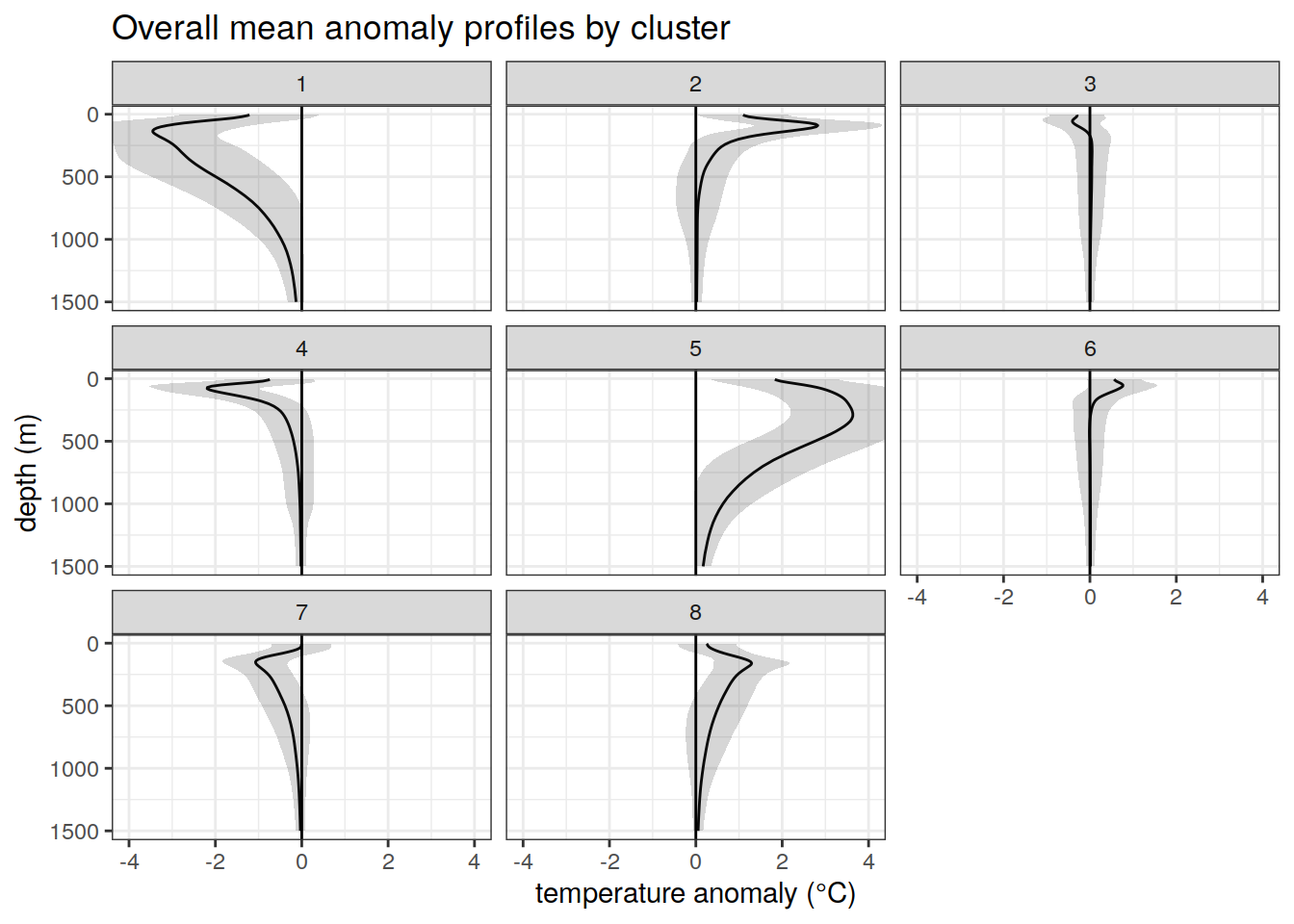
Cluster mean by year
if (opt_analysis_type == 2) {
# cluster means by year
anomaly_cluster_mean_year %>%
mutate(year = as.factor(year)) %>%
ggplot() +
geom_path(aes(x = anomaly_mean,
y = depth,
col = year)) +
geom_vline(xintercept = 0) +
scale_y_reverse() +
facet_wrap( ~ cluster) +
coord_cartesian(xlim = opt_xlim) +
scale_x_continuous(breaks = opt_xbreaks) +
scale_color_viridis_d() +
labs(
title = paste0('Overall mean anomaly profiles by cluster'),
x = opt_measure_label,
y = 'depth (m)'
)
}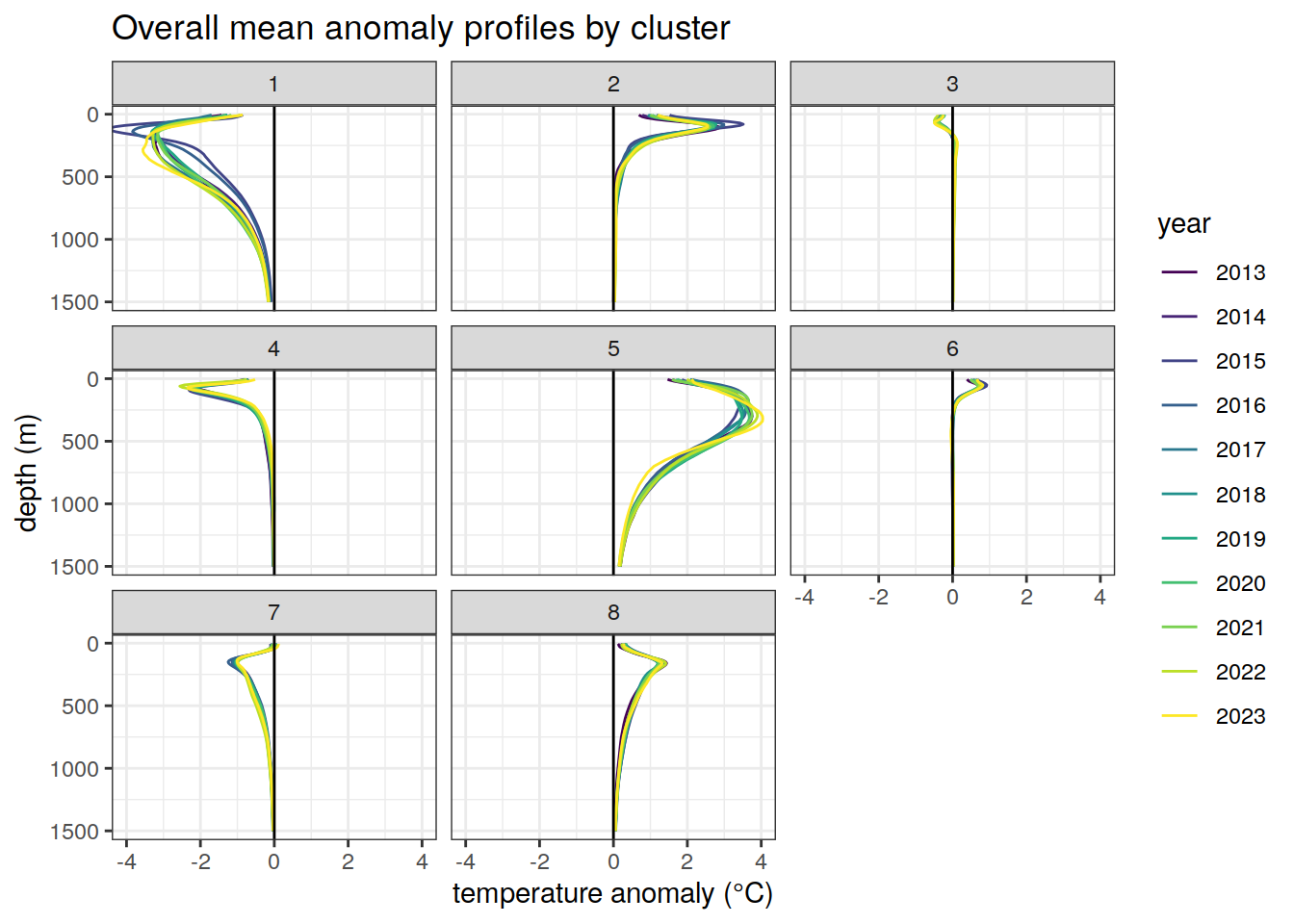
| Version | Author | Date |
|---|---|---|
| 77cc54e | ds2n19 | 2023-11-24 |
Cluster by year
count of each cluster by year
if (opt_analysis_type == 2) {
# Determine profile count by cluster and year
cluster_by_year <- temp_anomaly_cluster %>%
count(cluster, year,
name = "count_cluster")
year_min <- min(cluster_by_year$year)
year_max <- max(cluster_by_year$year)
# create figure
cluster_by_year %>%
ggplot(aes(x = year, y = count_cluster, col = cluster, group=cluster))+
geom_point() +
geom_line() +
scale_x_continuous(breaks = seq(year_min, year_max, 2)) +
scale_color_brewer(palette = 'Dark2')+
labs(x = 'year',
y = 'number of profiles',
col = 'cluster',
title = 'Count of profiles by year and cluster')
}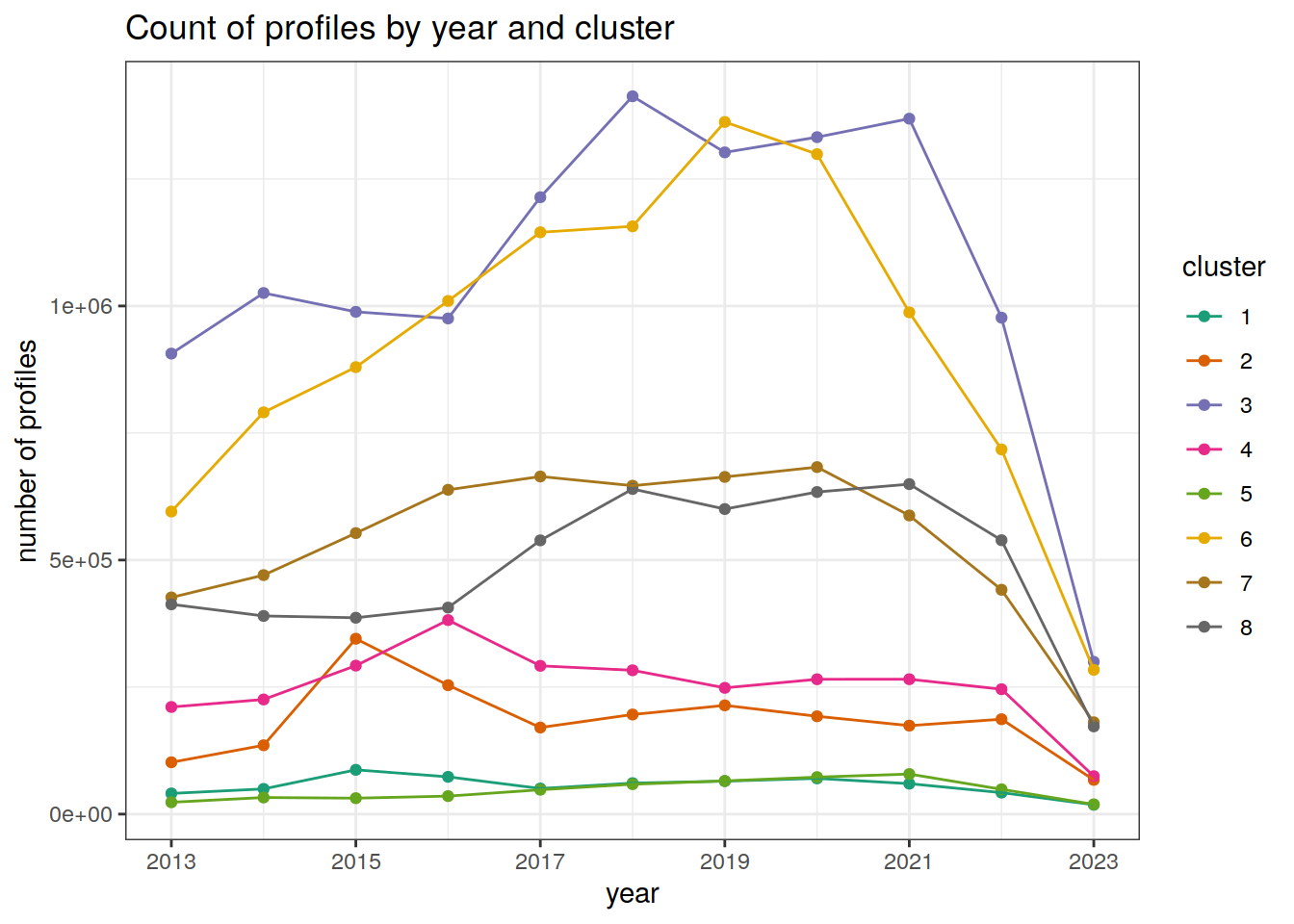
Cluster by month
count of each cluster by month of year
if (opt_analysis_type == 2) {
# Determine profile count by cluster and year
cluster_by_year <- temp_anomaly_cluster %>%
count(cluster, month,
name = "count_cluster")
# create figure
cluster_by_year %>%
ggplot(aes(x = month, y = count_cluster, col = cluster, group=cluster))+
geom_point() +
geom_line() +
scale_x_continuous(breaks = seq(1, 12, 2)) +
scale_color_brewer(palette = 'Dark2')+
labs(x = 'month',
y = 'number of profiles',
col = 'cluster',
title = 'Count of profiles by month and cluster')
}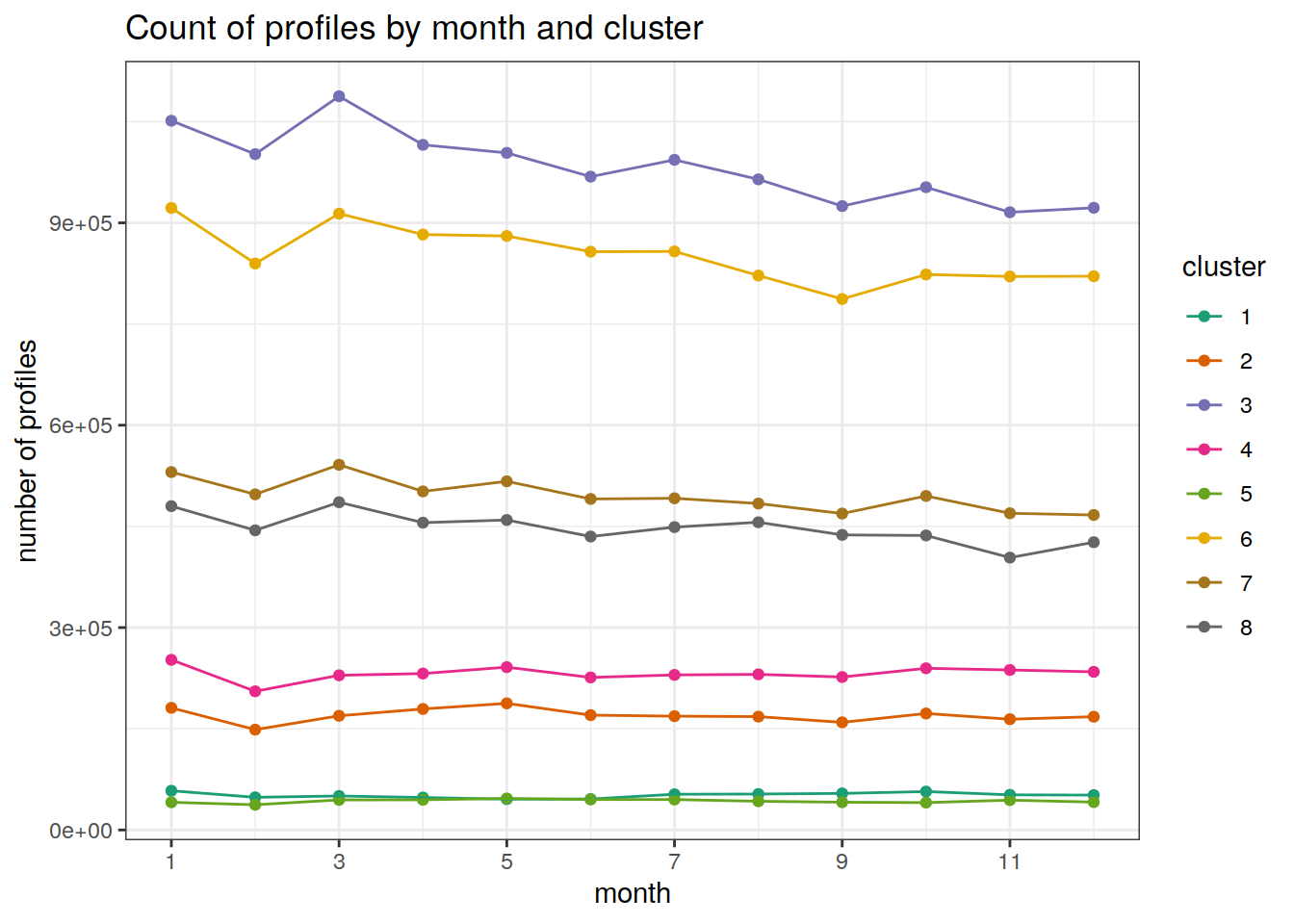
Cluster spatial
location of each cluster on map, spatial analysis
if (opt_analysis_type == 2) {
# create figure
map +
geom_tile(data = temp_anomaly_cluster,
aes(x = lon,
y = lat,
fill = cluster))+
scale_fill_brewer(palette = 'Dark2')+
labs(title = 'cluster spatial distribution')
}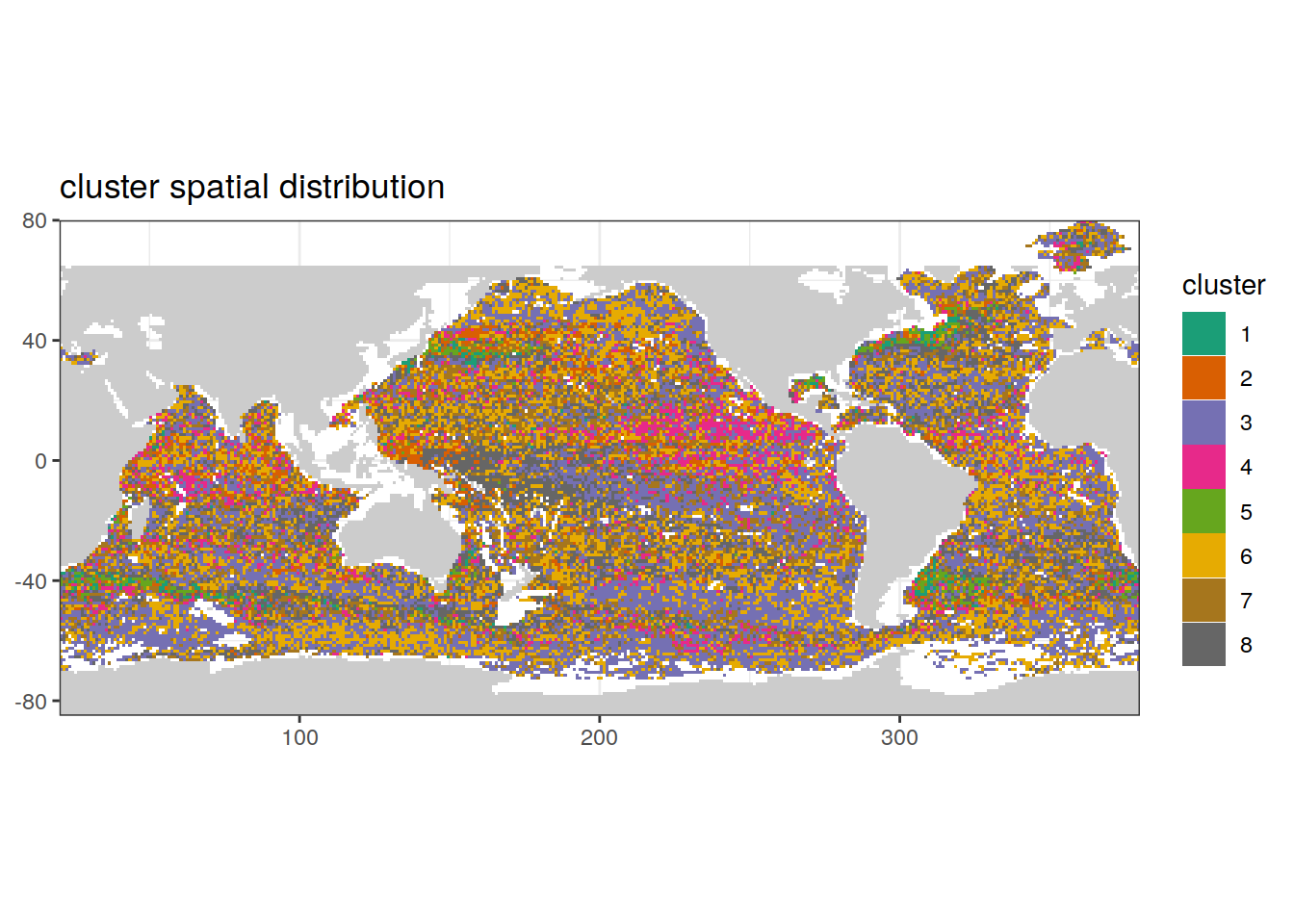
location of each cluster on separate maps, spatial analysis
if (opt_analysis_type == 2) {
# create figure
map +
geom_tile(data = temp_anomaly_cluster,
aes(x = lon,
y = lat,
fill = cluster)) +
scale_fill_brewer(palette = 'Dark2') +
facet_wrap( ~ cluster, ncol = 2) +
labs(title = 'cluster spatial distribution')
}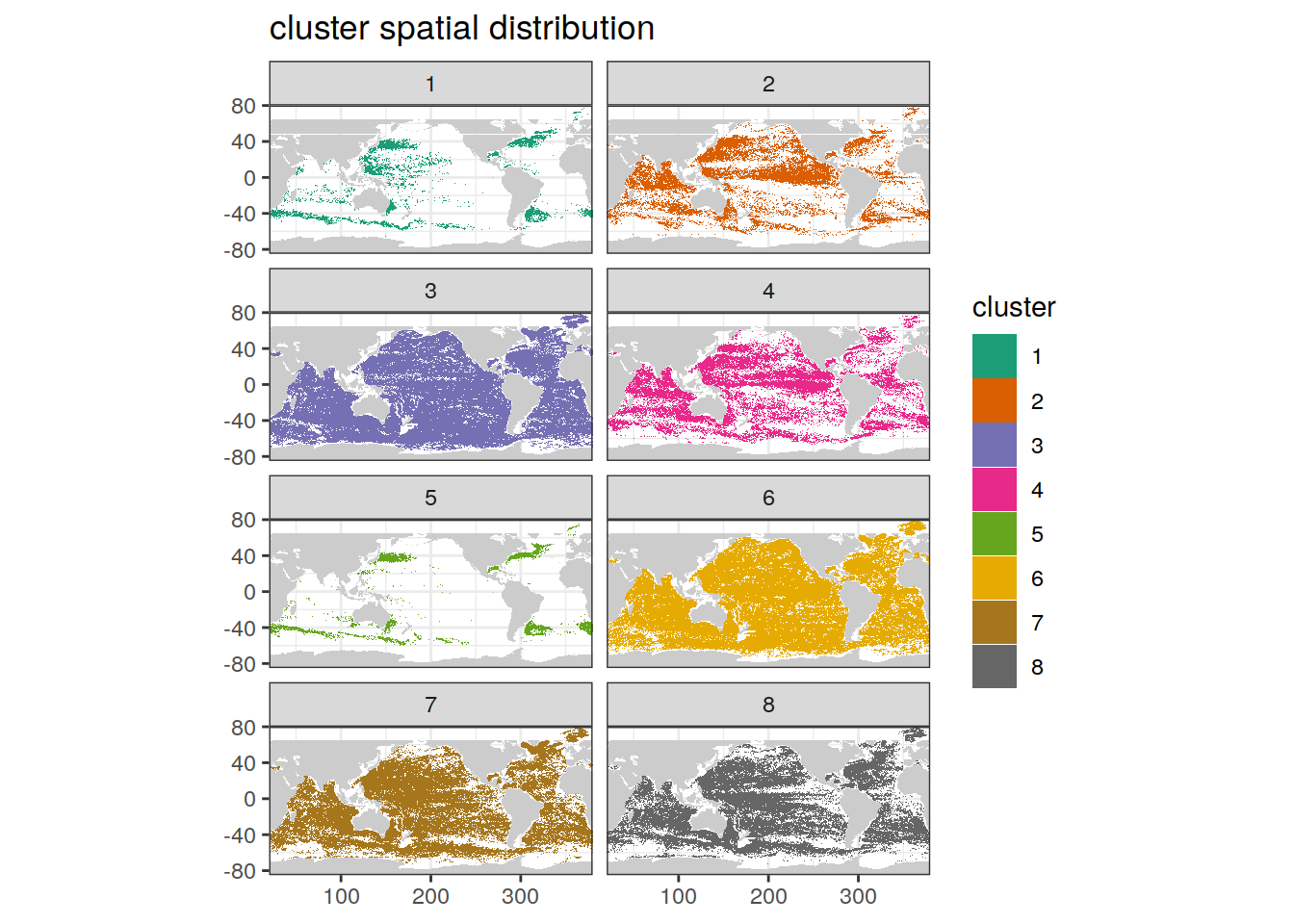
count of measurements for each cluster on separate maps, spatial analysis
if (opt_analysis_type == 2) {
# create figure
map +
geom_tile(data = temp_anomaly_cluster %>%
count(lat, lon, cluster),
aes(x = lon,
y = lat,
fill = n)) +
scale_fill_viridis_c(option = "cividis", direction = -1, trans = "log10") +
facet_wrap( ~ cluster, ncol = 2) +
labs(title = 'cluster spatial distribution')
}
| Version | Author | Date |
|---|---|---|
| 77cc54e | ds2n19 | 2023-11-24 |
Cluster spatial year
location of each cluster on map, spatial analysis by year
if (opt_analysis_type == 2) {
# create figure
temp_anomaly_cluster %>%
group_split(year) %>%
map(
~ map +
geom_tile(data = .x,
aes(
x = lon,
y = lat,
fill = cluster
)) +
scale_fill_brewer(palette = 'Dark2') +
facet_wrap( ~ cluster, ncol = 2) +
labs(title = paste0(
'cluster spatial distribution ', unique(.x$year)
))
)
}[[1]]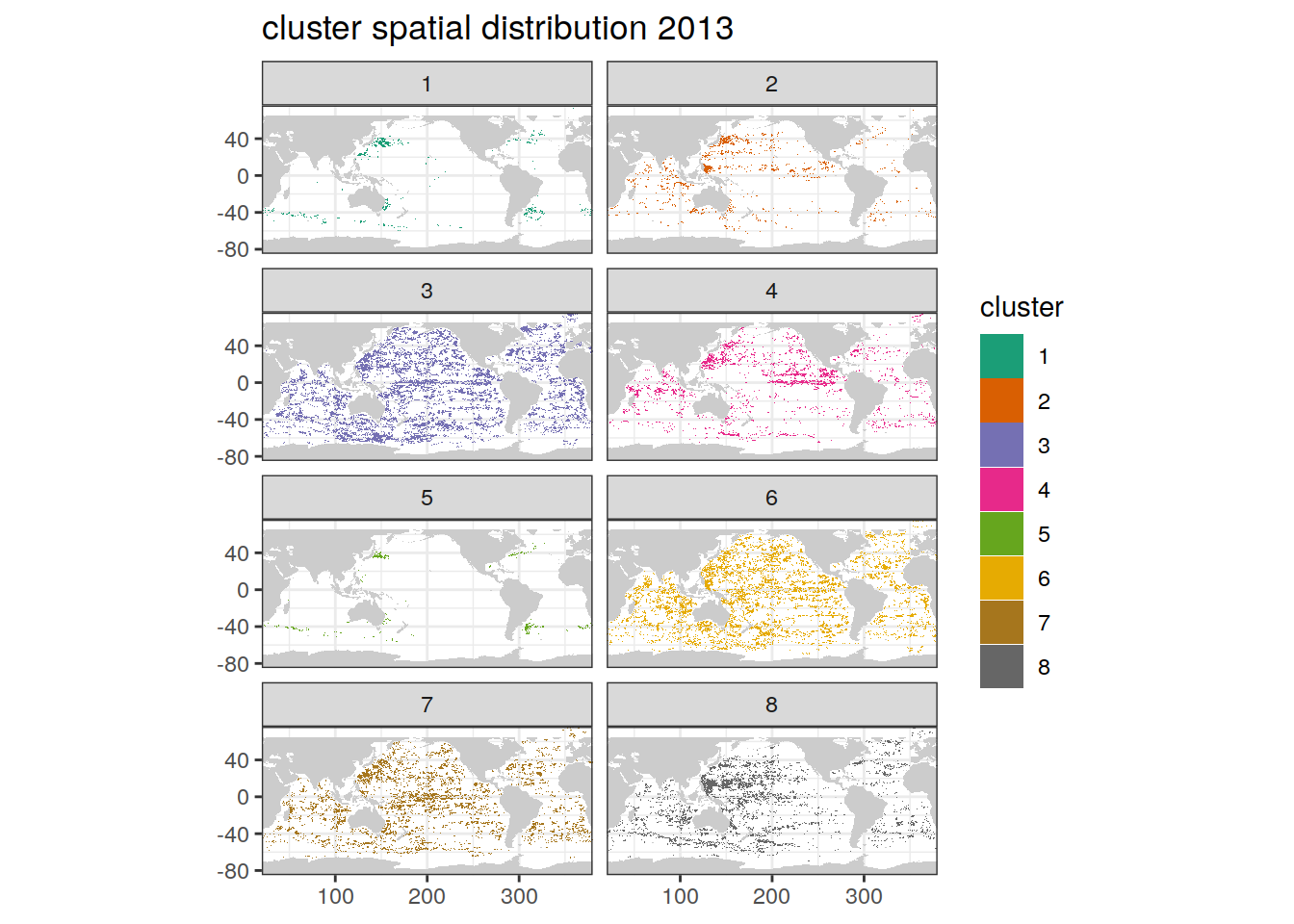
[[2]]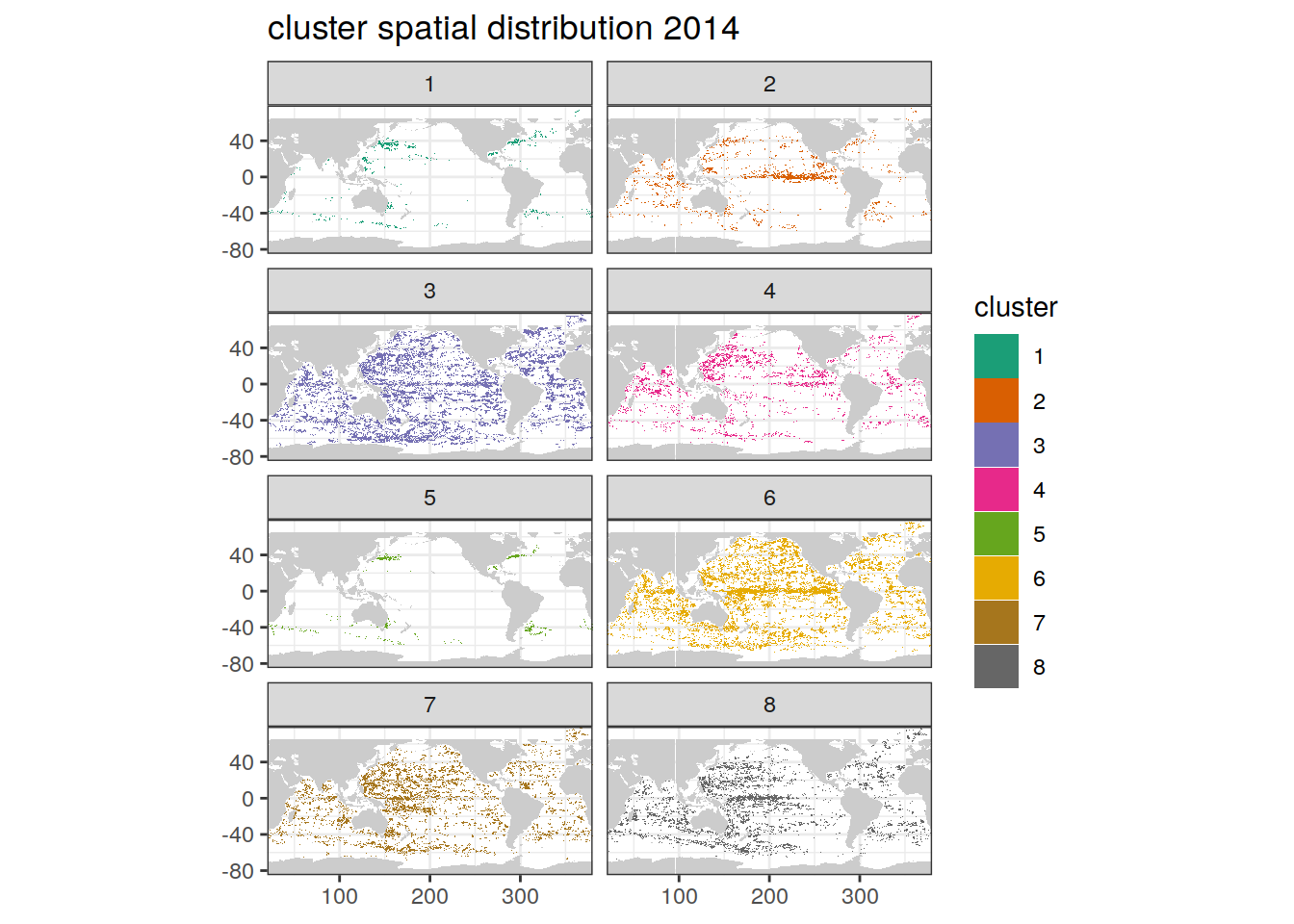
[[3]]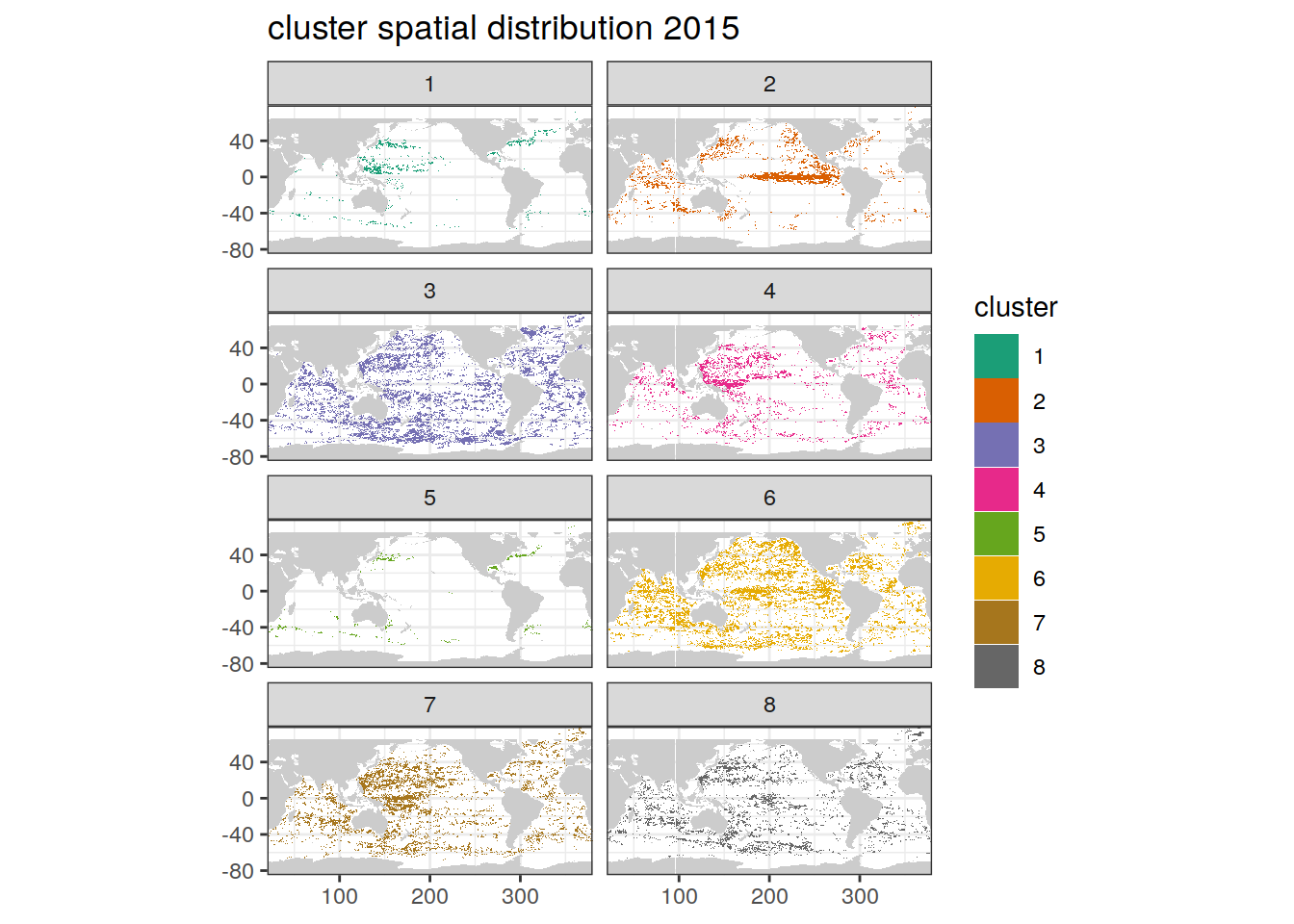
[[4]]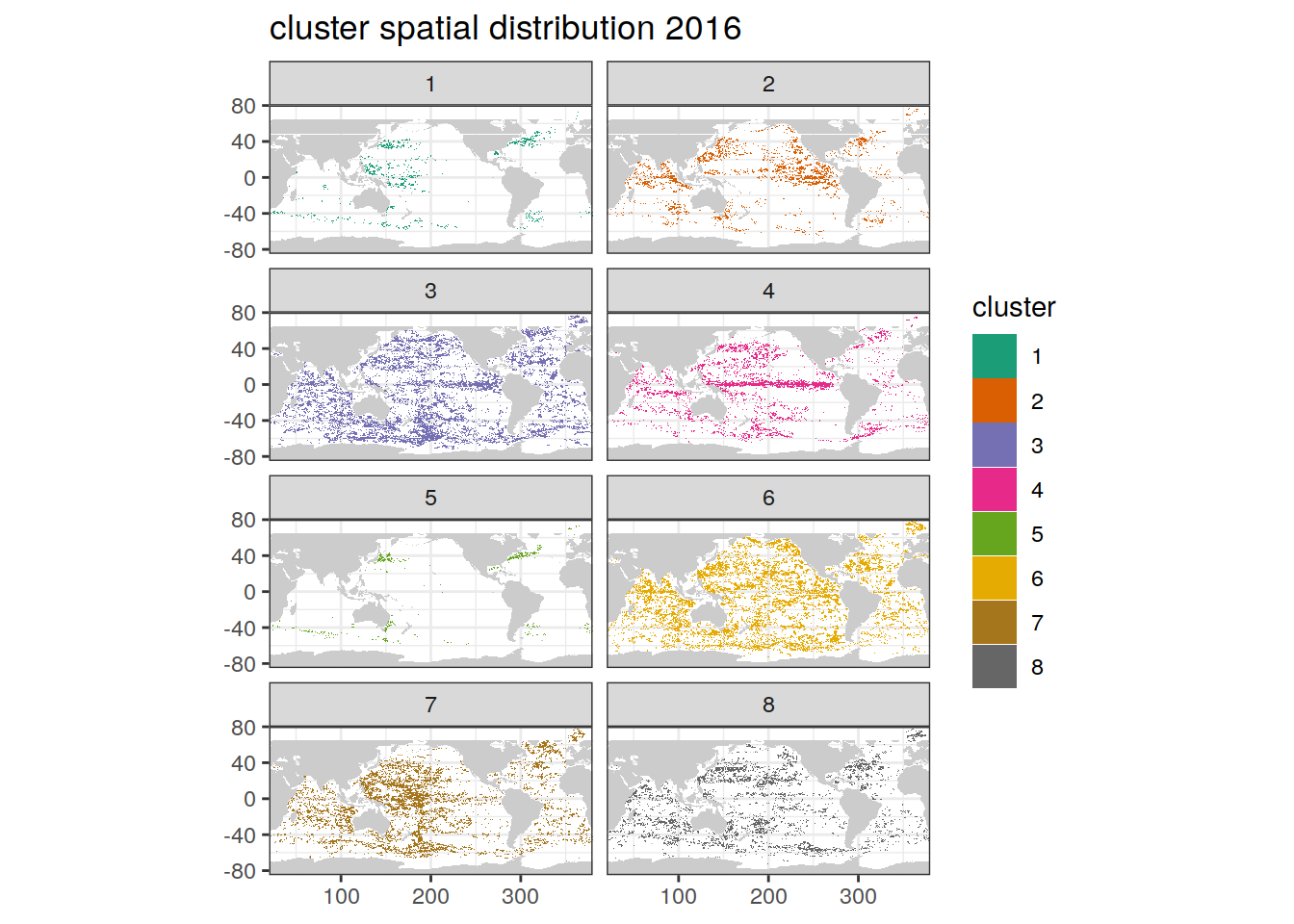
[[5]]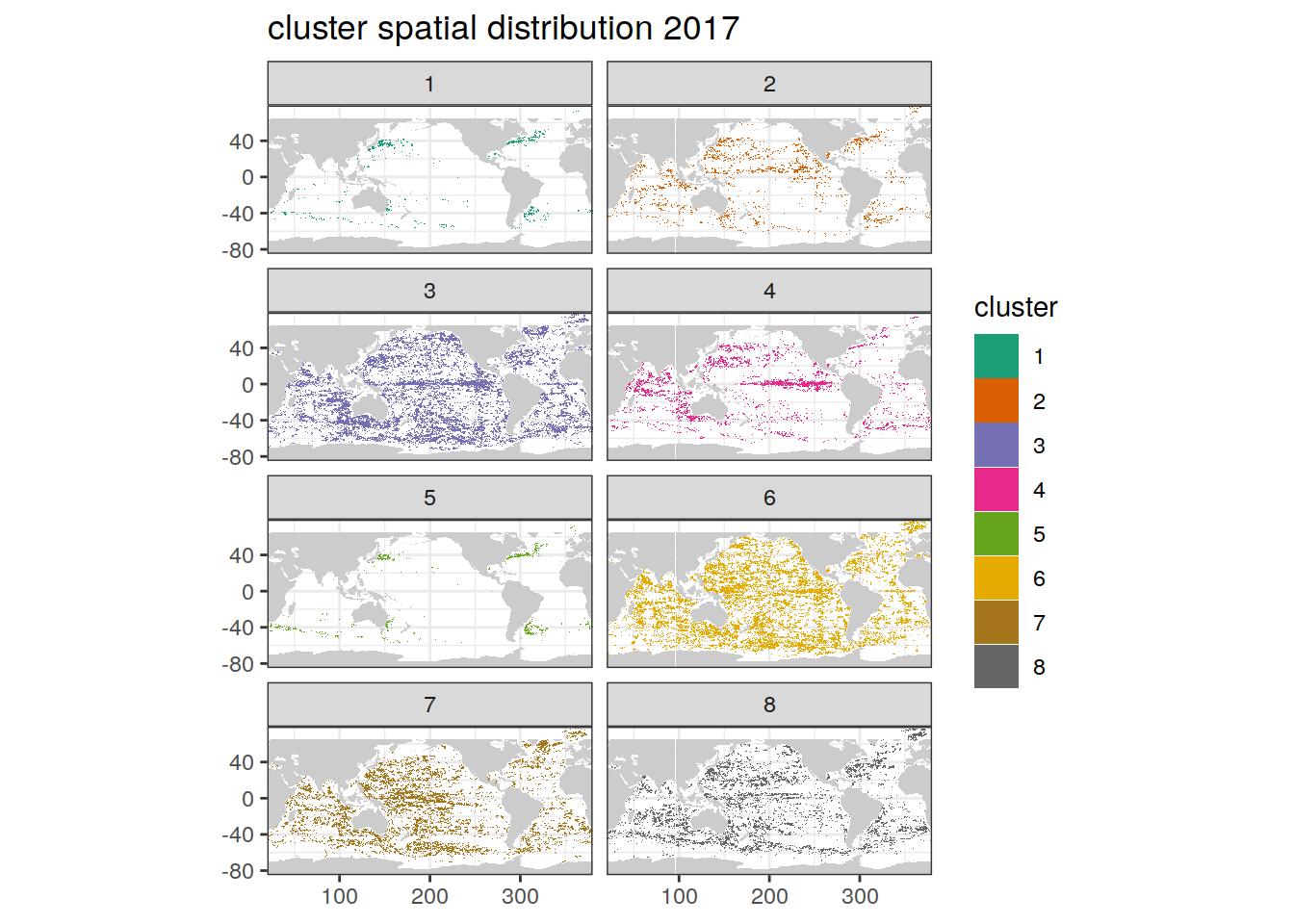
[[6]]
[[7]]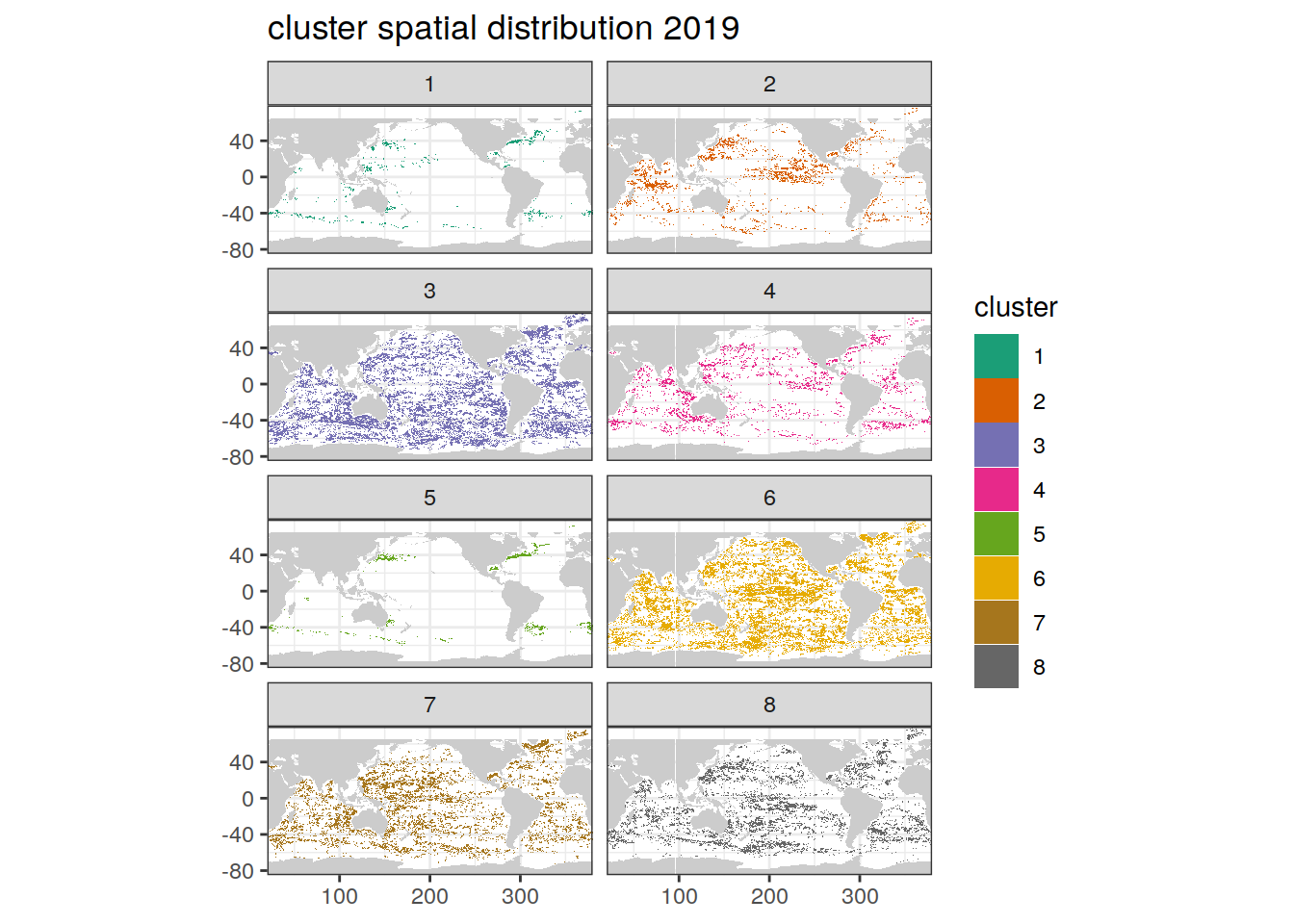
[[8]]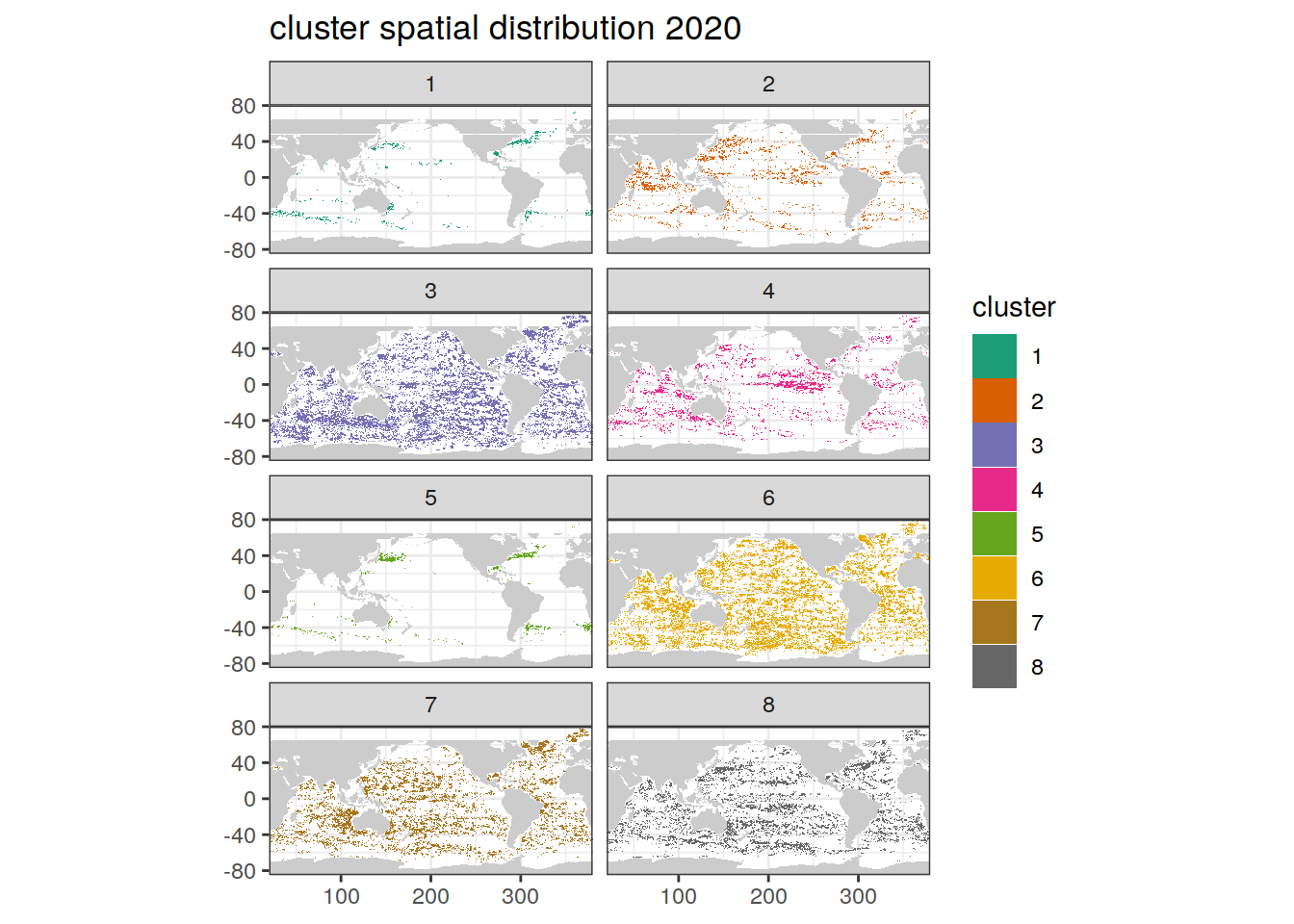
[[9]]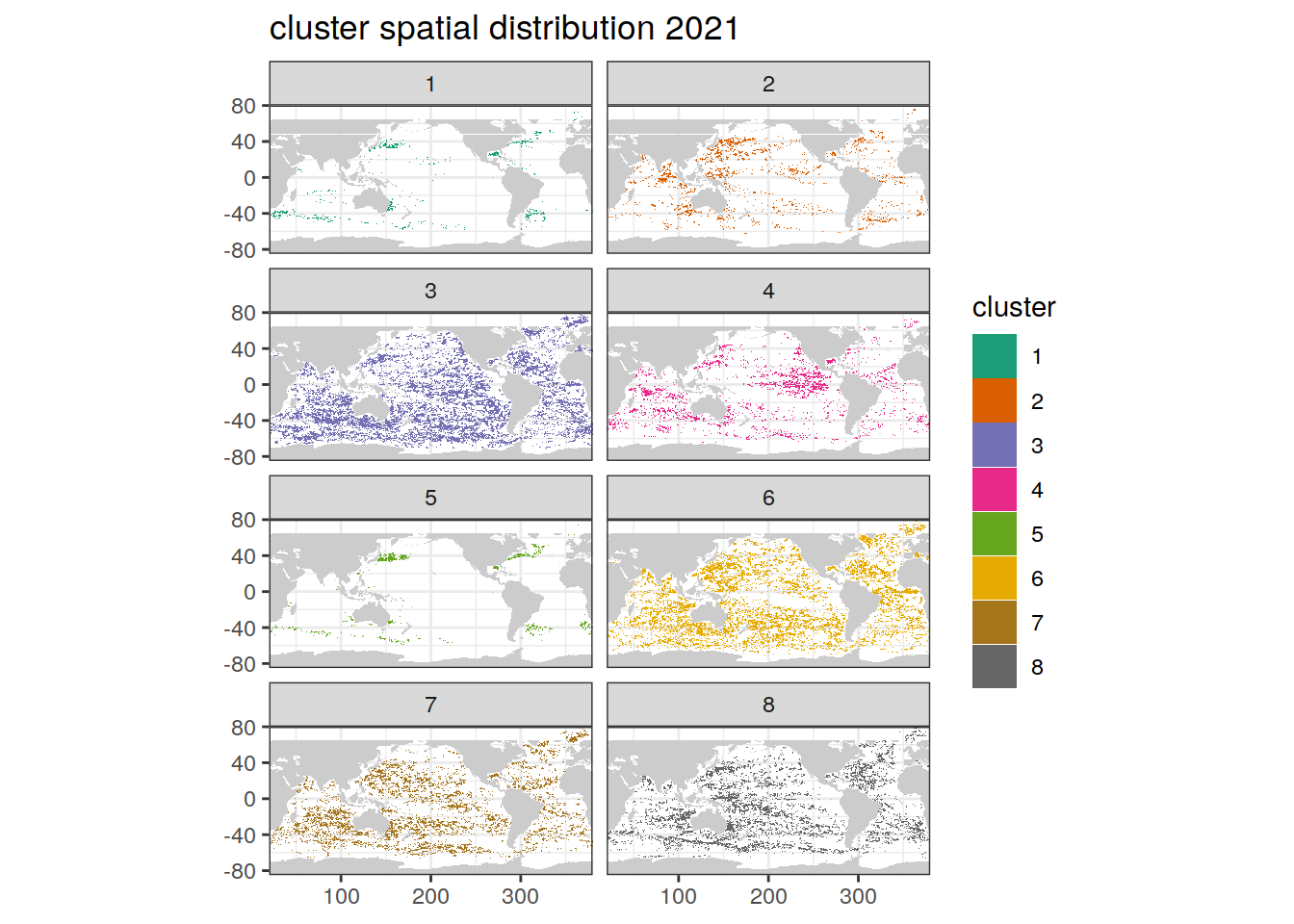
[[10]]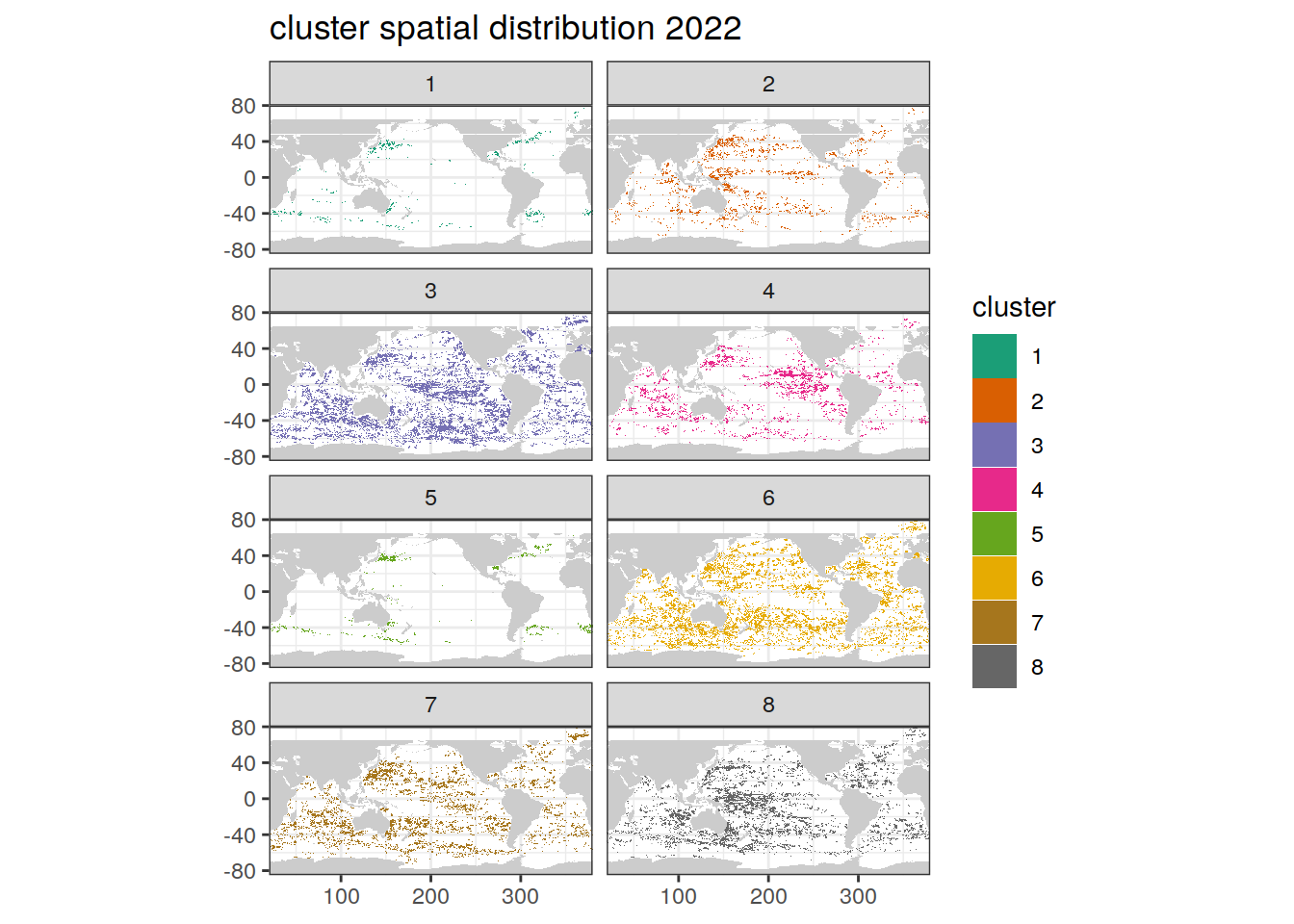
[[11]]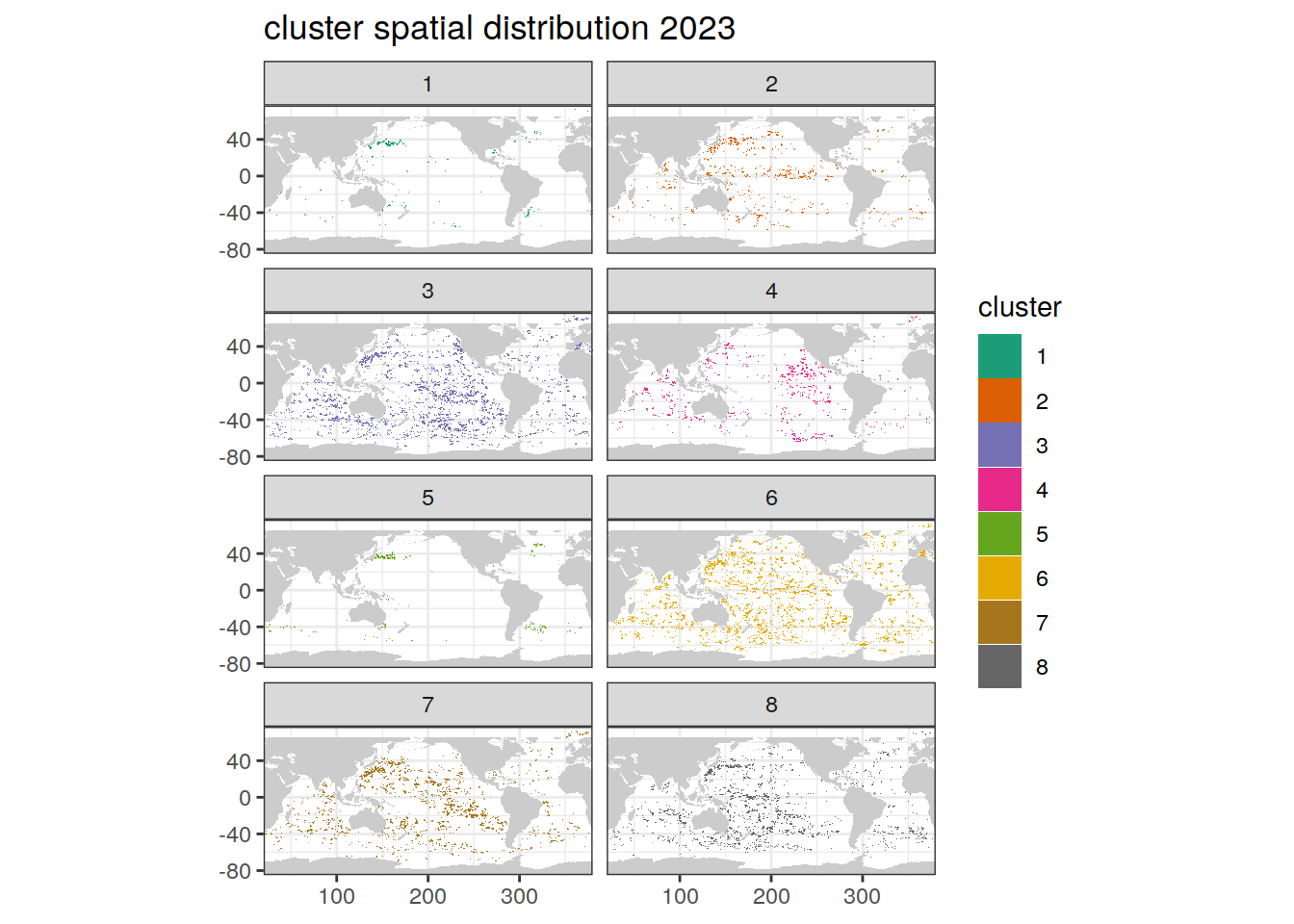
Cluster by surface Extreme
# Carried out for 1500m profiles
opt_profile_range = 3
extreme_type <- c('L', 'N', 'H')
num_clusters <- c(5, 6, 5)
# ---------------------------------------------------------------------------------------------
# read data
# ---------------------------------------------------------------------------------------------
# load previously created OceanSODA extreme data. date, position and nature of extreme
if (opt_extreme_determination == 1){
temp_extreme <- read_rds(file = paste0(path_argo_preprocessed, "/OceanSODA_global_SST_anomaly_field_01.rds")) %>%
select(lon, lat, date, temp_extreme)
} else if (opt_extreme_determination == 2){
temp_extreme <- read_rds(file = paste0(path_argo_preprocessed, "/OceanSODA_global_SST_anomaly_field_02.rds")) %>%
select(lon, lat, date, temp_extreme)
}
# read data
temp_anomaly_va <- read_rds(file = paste0(path_core_preprocessed, "/temp_anomaly_va.rds")) %>%
mutate(date = ymd(format(date, "%Y-%m-15")))
# Add the OceanSODA extreme condition
temp_anomaly_va <- left_join(temp_anomaly_va, temp_extreme)
for (i in 1:3) {
# ---------------------------------------------------------------------------------------------
# Preparation
# ---------------------------------------------------------------------------------------------
# select profile based on profile_range and he appropriate max depth
temp_anomaly_va_id <- temp_anomaly_va %>%
filter(profile_range == opt_profile_range & depth <= opt_max_depth[opt_profile_range] & temp_extreme == extreme_type[i])
# Simplified table ready to pivot
temp_anomaly_va_id <- temp_anomaly_va_id %>%
select(file_id,
depth,
anomaly,
year,
month,
lat,
lon)
# wide table with each depth becoming a column
temp_anomaly_va_wide <- temp_anomaly_va_id %>%
select(file_id, depth, anomaly) %>%
pivot_wider(names_from = depth, values_from = anomaly)
# Drop any rows with missing values N/A caused by gaps in climatology data
temp_anomaly_va_wide <- temp_anomaly_va_wide %>%
drop_na()
# Table for cluster analysis
points <- temp_anomaly_va_wide %>%
column_to_rownames(var = "file_id")
# ---------------------------------------------------------------------------------------------
# cluster analysis
# ---------------------------------------------------------------------------------------------
set.seed(1)
kclusts <-
tibble(k = num_clusters[i]) %>%
mutate(
kclust = map(k, ~ kmeans(points, .x, iter.max = opt_max_iterations, nstart = opt_n_start)),
tidied = map(kclust, tidy),
glanced = map(kclust, glance),
augmented = map(kclust, augment, points)
)
profile_id <-
kclusts %>%
unnest(cols = c(augmented)) %>%
select(file_id = .rownames,
cluster = .cluster) %>%
mutate(file_id = as.numeric(file_id),
cluster = as.character(cluster))
# Add cluster to temp_anomaly_va
temp_anomaly_cluster <- full_join(temp_anomaly_va, profile_id)
# Plot cluster mean
temp_anomaly_cluster <- temp_anomaly_cluster %>%
filter(!is.na(cluster))
# Plot cluster mean
anomaly_cluster_mean <- temp_anomaly_cluster %>%
group_by(cluster, depth) %>%
summarise(
count_cluster = n(),
anomaly_mean = mean(anomaly, na.rm = TRUE),
anomaly_sd = sd(anomaly, na.rm = TRUE)
) %>%
ungroup()
anomaly_cluster_mean_year <- temp_anomaly_cluster %>%
group_by(cluster, depth, year) %>%
summarise(
count_cluster = n(),
anomaly_mean = mean(anomaly, na.rm = TRUE),
anomaly_sd = sd(anomaly, na.rm = TRUE)
) %>%
ungroup()
anomaly_year_mean <- temp_anomaly_cluster %>%
group_by(cluster, year) %>%
summarise(
count_cluster = n(),
anomaly_mean = mean(anomaly, na.rm = TRUE),
anomaly_sd = sd(anomaly, na.rm = TRUE)
) %>%
ungroup()
anomaly_year_mean <- anomaly_year_mean %>%
group_by(year) %>%
summarise(anomaly_mean = mean(anomaly_mean, na.rm = TRUE)) %>%
ungroup ()
if (i == 1) {
anomaly_cluster_mean_ext <- anomaly_cluster_mean %>% mutate(temp_extreme_order = i, temp_extreme = extreme_type[i])
anomaly_cluster_mean_year_ext <- anomaly_cluster_mean_year %>% mutate(temp_extreme_order = i, temp_extreme = extreme_type[i])
anomaly_year_mean_ext <- anomaly_year_mean %>% mutate(temp_extreme_order = i, temp_extreme = extreme_type[i])
temp_anomaly_cluster_ext <- temp_anomaly_cluster %>% mutate(temp_extreme_order = i, temp_extreme = extreme_type[i])
} else {
anomaly_cluster_mean_ext <- rbind(anomaly_cluster_mean_ext, anomaly_cluster_mean %>% mutate(temp_extreme_order = i, temp_extreme = extreme_type[i]))
anomaly_cluster_mean_year_ext <- rbind(anomaly_cluster_mean_year_ext, anomaly_cluster_mean_year %>% mutate(temp_extreme_order = i, temp_extreme = extreme_type[i]))
anomaly_year_mean_ext <- rbind(anomaly_year_mean_ext, anomaly_year_mean %>% mutate(temp_extreme_order = i, temp_extreme = extreme_type[i]))
temp_anomaly_cluster_ext <- rbind(temp_anomaly_cluster_ext, temp_anomaly_cluster_ext <- temp_anomaly_cluster %>% mutate(temp_extreme_order = i, temp_extreme = extreme_type[i]))
}
}Cluster mean
# create figure of mean clusters
anomaly_cluster_mean_ext %>%
group_split(temp_extreme_order) %>%
map(
~ ggplot(data = .x, ) +
geom_path(aes(x = anomaly_mean,
y = depth)) +
geom_ribbon(
aes(
xmax = anomaly_mean + anomaly_sd,
xmin = anomaly_mean - anomaly_sd,
y = depth
),
alpha = 0.2
) +
geom_vline(xintercept = 0) +
scale_y_reverse() +
facet_wrap(~ cluster) +
coord_cartesian(xlim = opt_xlim) +
scale_x_continuous(breaks = opt_xbreaks) +
labs(
title = paste0(
'Overall mean anomaly profiles by cluster \n',
'Surface extreme: ',
unique(.x$temp_extreme)
),
x = opt_measure_label,
y = 'depth (m)'
)
)[[1]]
| Version | Author | Date |
|---|---|---|
| 77cc54e | ds2n19 | 2023-11-24 |
[[2]]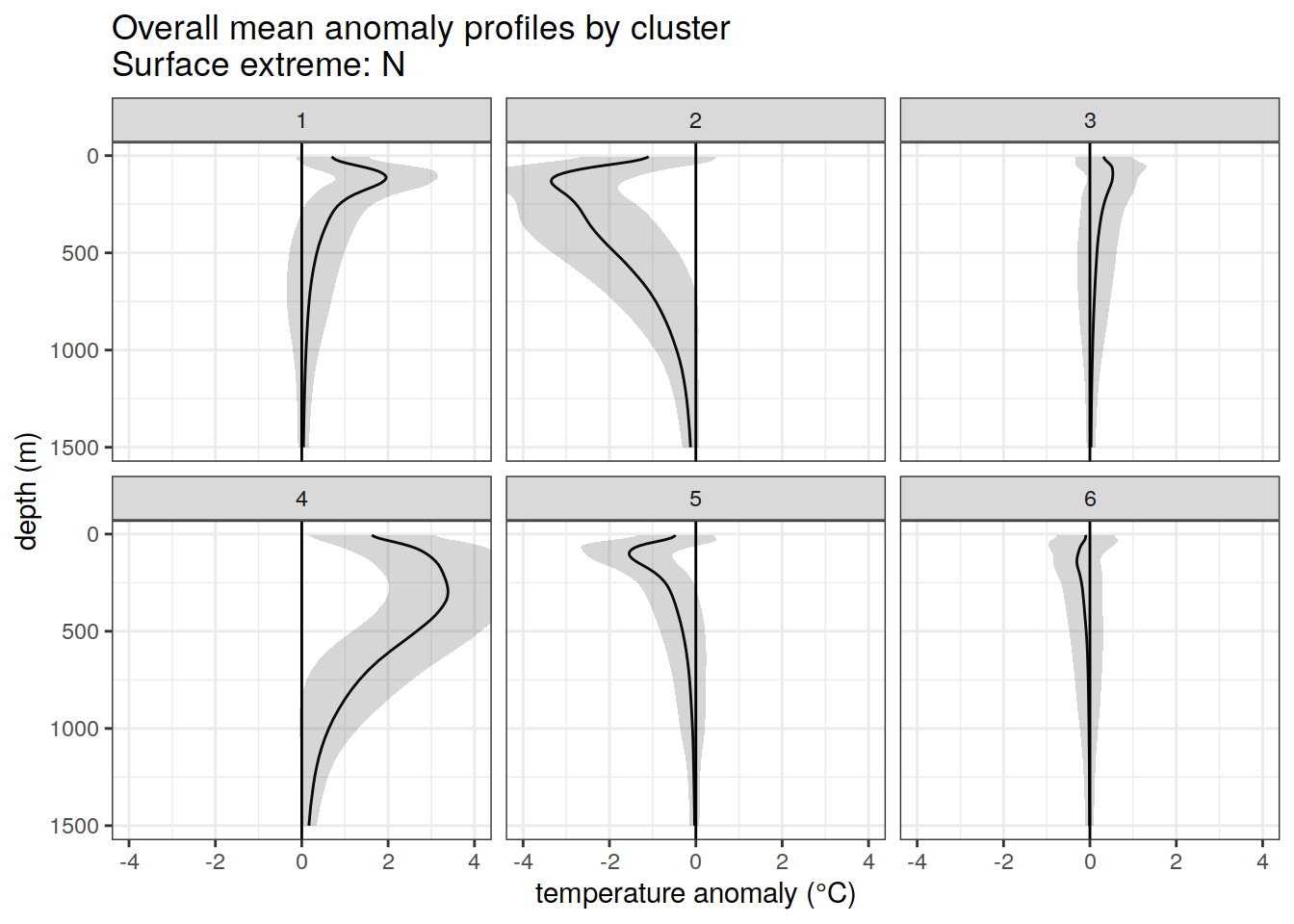
| Version | Author | Date |
|---|---|---|
| 77cc54e | ds2n19 | 2023-11-24 |
[[3]]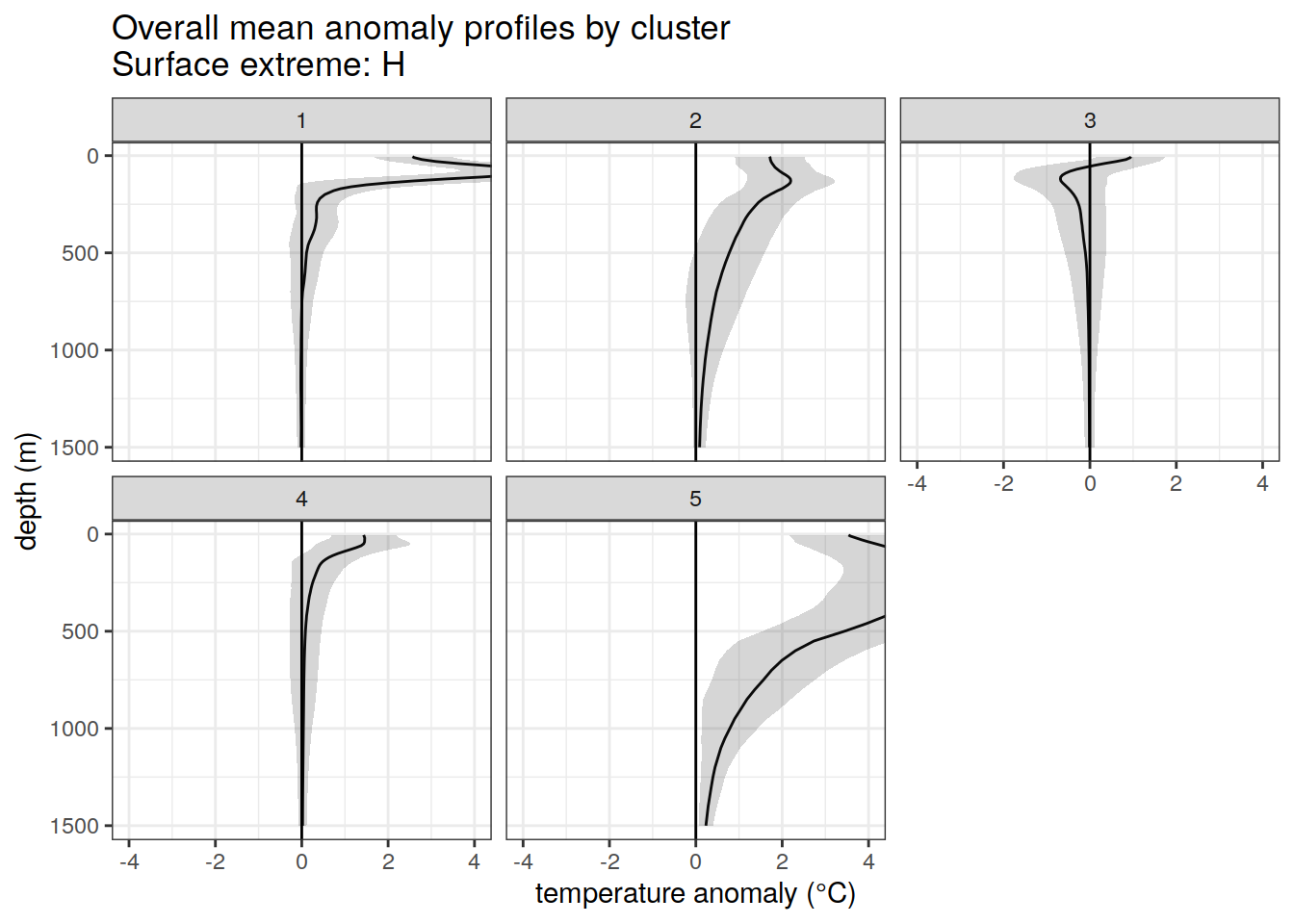
| Version | Author | Date |
|---|---|---|
| 77cc54e | ds2n19 | 2023-11-24 |
Clusters mean by year
# cluster means by year
anomaly_cluster_mean_year_ext %>%
mutate(year = as.factor(year)) %>%
group_split(temp_extreme_order) %>%
map(
~ ggplot(data = .x,) +
geom_path(aes(
x = anomaly_mean,
y = depth,
col = year
)) +
geom_vline(xintercept = 0) +
scale_y_reverse() +
facet_wrap(~ cluster) +
coord_cartesian(xlim = opt_xlim) +
scale_x_continuous(breaks = opt_xbreaks) +
scale_color_viridis_d() +
labs(
title = paste0(
'Overall mean anomaly profiles by cluster by year \n',
'Surface extreme: ',
unique(.x$temp_extreme)
),
x = opt_measure_label,
y = 'depth (m)'
)
)[[1]]
| Version | Author | Date |
|---|---|---|
| 77cc54e | ds2n19 | 2023-11-24 |
[[2]]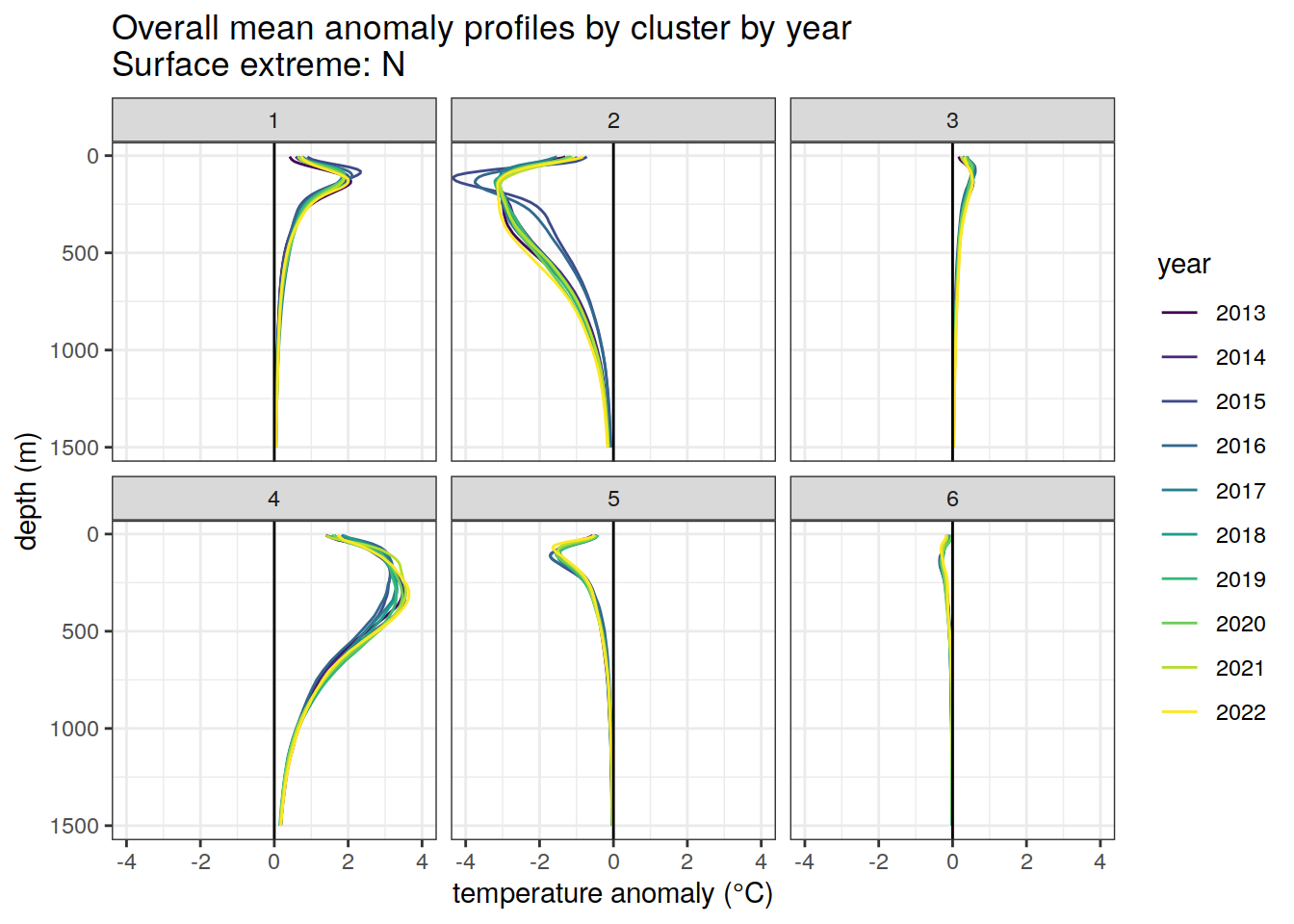
| Version | Author | Date |
|---|---|---|
| 77cc54e | ds2n19 | 2023-11-24 |
[[3]]
| Version | Author | Date |
|---|---|---|
| 77cc54e | ds2n19 | 2023-11-24 |
Cluster by year
count of each cluster by year
# Determine profile count by extreme and cluster and year
# Count the measurements
cluster_by_year <- temp_anomaly_cluster_ext %>%
count(file_id, temp_extreme_order, temp_extreme, cluster, year,
name = "count_cluster")
# Convert to profiles
cluster_by_year <- cluster_by_year %>%
count(temp_extreme_order, temp_extreme, cluster, year,
name = "count_cluster")
year_min <- min(cluster_by_year$year)
year_max <- max(cluster_by_year$year)
# create figure
cluster_by_year %>%
group_split(temp_extreme_order) %>%
map(
~ ggplot(
data = .x,
aes(
x = year,
y = count_cluster,
col = cluster,
group = cluster
)
) +
geom_point() +
geom_line() +
scale_x_continuous(breaks = seq(year_min, year_max, 2)) +
scale_color_brewer(palette = 'Dark2') +
labs(
x = 'year',
y = 'number of profiles',
col = 'cluster',
title = paste0(
'Count of profiles by year and cluster \n',
'Surface extreme: ',
unique(.x$temp_extreme)
)
)
)[[1]]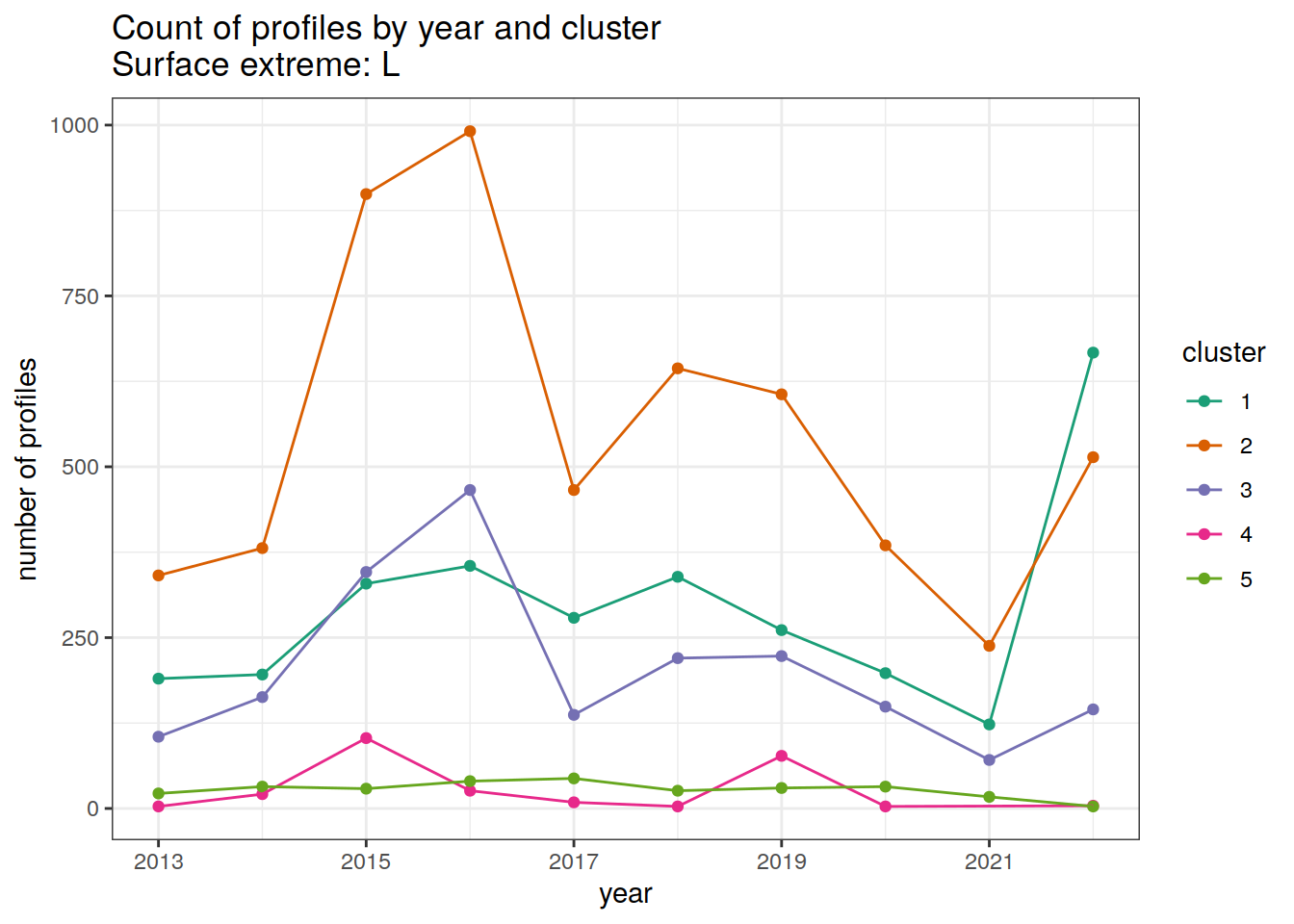
| Version | Author | Date |
|---|---|---|
| 77cc54e | ds2n19 | 2023-11-24 |
[[2]]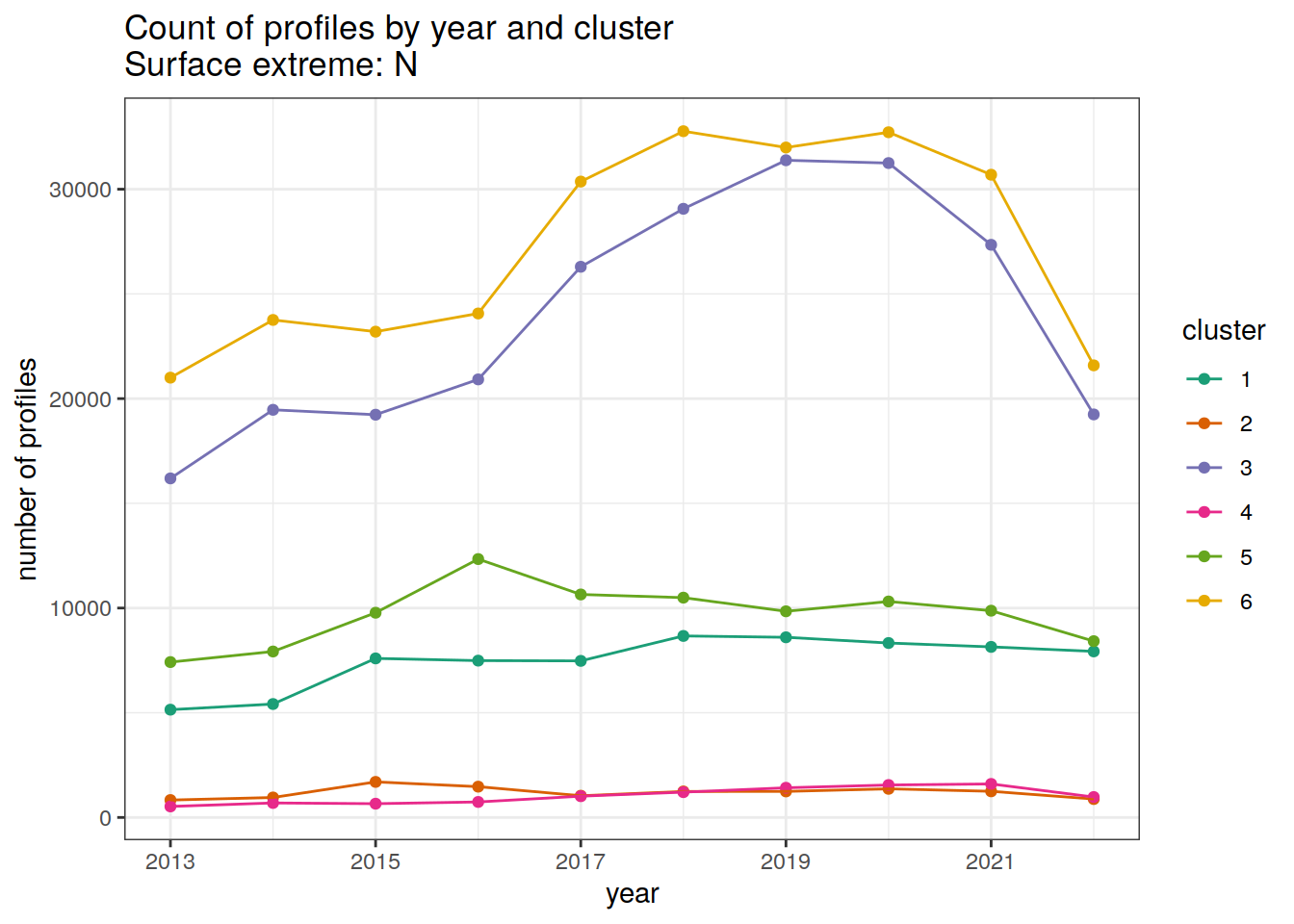
| Version | Author | Date |
|---|---|---|
| 77cc54e | ds2n19 | 2023-11-24 |
[[3]]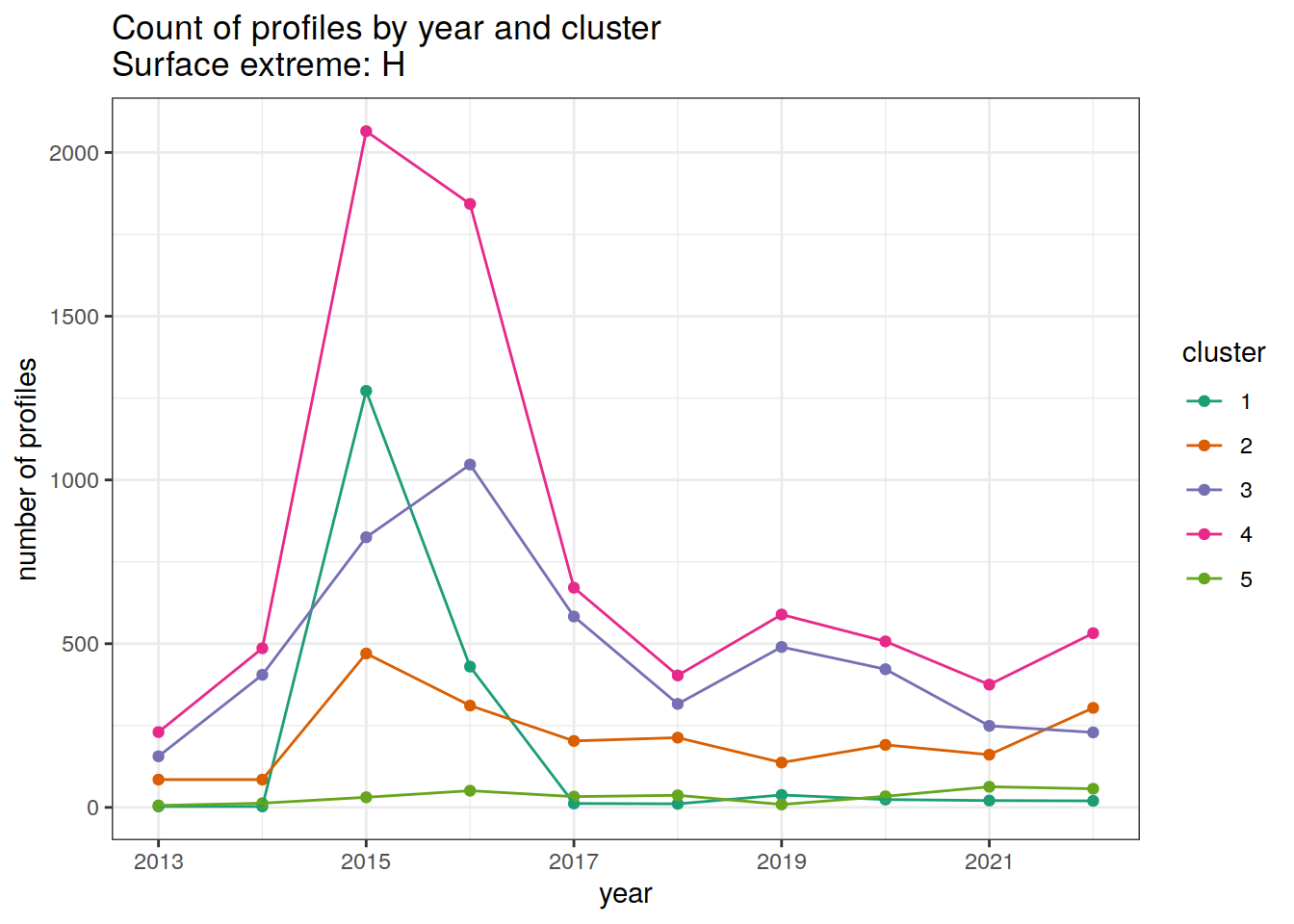
| Version | Author | Date |
|---|---|---|
| 77cc54e | ds2n19 | 2023-11-24 |
Cluster by month
count of each cluster by month of year
# Determine profile count by cluster and year
# Count the measurements
cluster_by_year <- temp_anomaly_cluster_ext %>%
count(file_id, temp_extreme_order, temp_extreme, cluster, month,
name = "count_cluster")
# Convert to profiles
cluster_by_year <- cluster_by_year %>%
count(temp_extreme_order, temp_extreme, cluster, month,
name = "count_cluster")
# create figure
cluster_by_year %>%
group_split(temp_extreme_order) %>%
map(
~ ggplot(
data = .x,
aes(
x = month,
y = count_cluster,
col = cluster,
group = cluster
)
) +
geom_point() +
geom_line() +
scale_x_continuous(breaks = seq(1, 12, 2)) +
scale_color_brewer(palette = 'Dark2') +
labs(
x = 'month',
y = 'number of profiles',
col = 'cluster',
title = paste0(
'Count of profiles by month and cluster \n',
'Surface extreme: ',
unique(.x$temp_extreme)
)
)
)[[1]]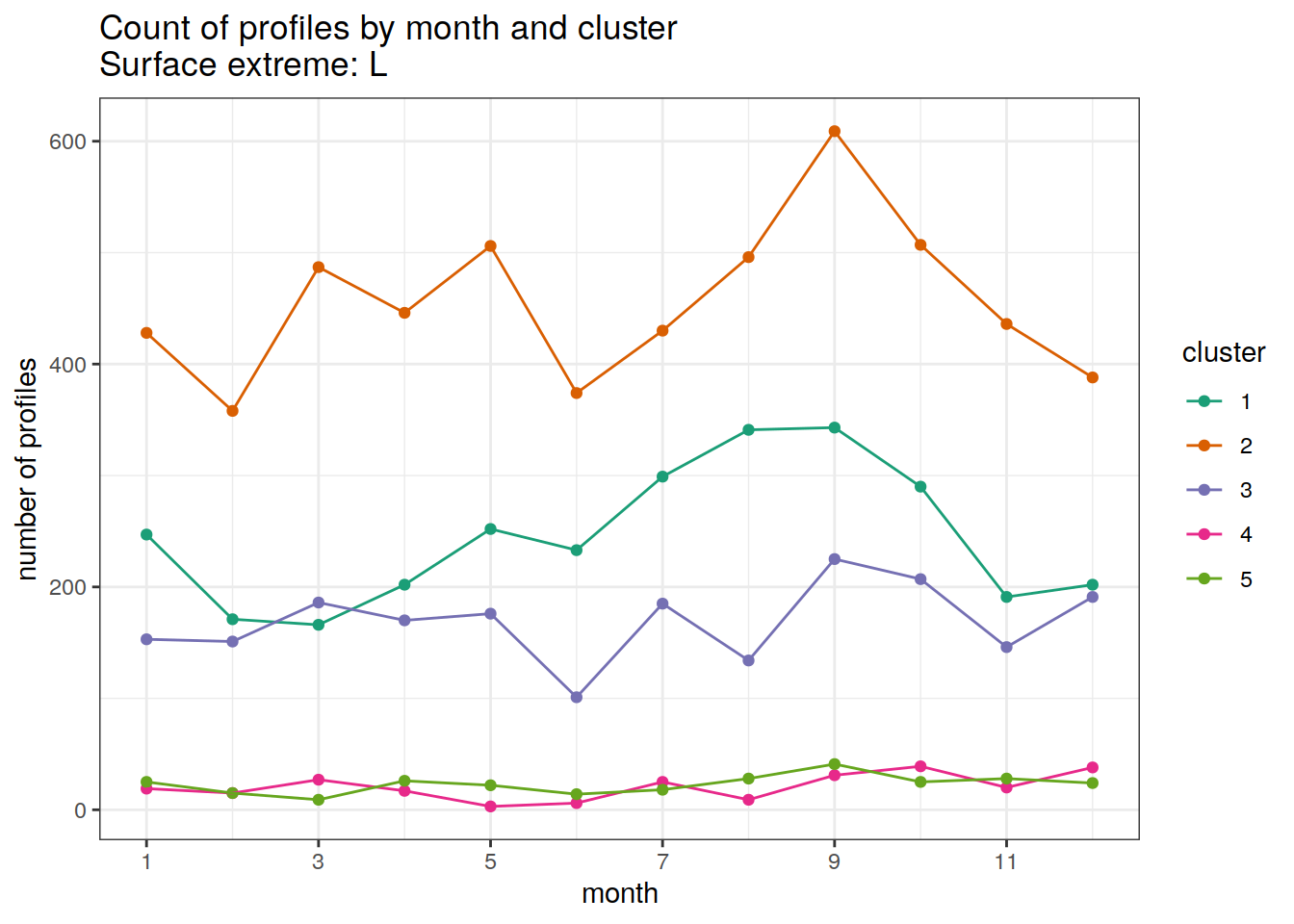
| Version | Author | Date |
|---|---|---|
| 77cc54e | ds2n19 | 2023-11-24 |
[[2]]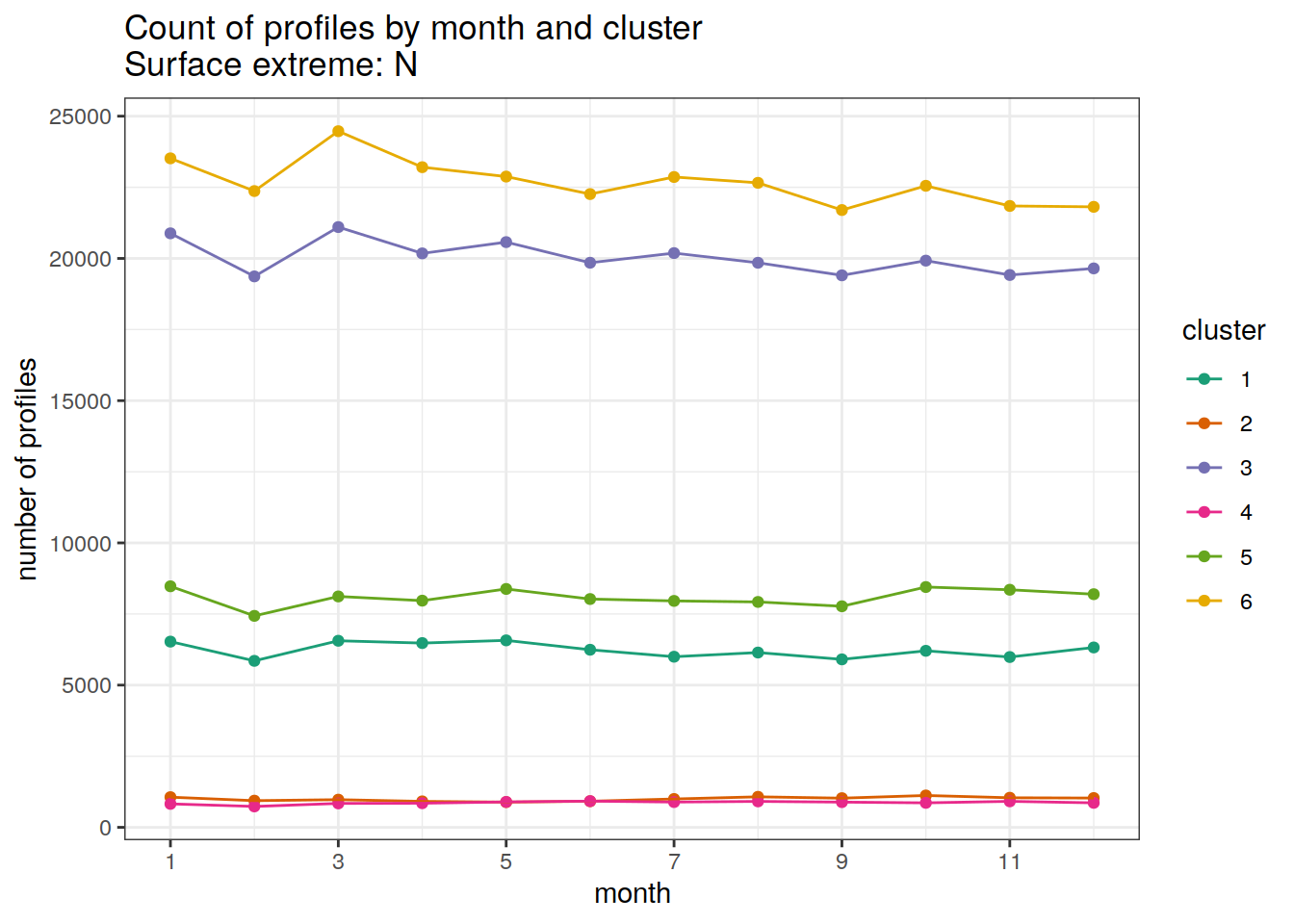
| Version | Author | Date |
|---|---|---|
| 77cc54e | ds2n19 | 2023-11-24 |
[[3]]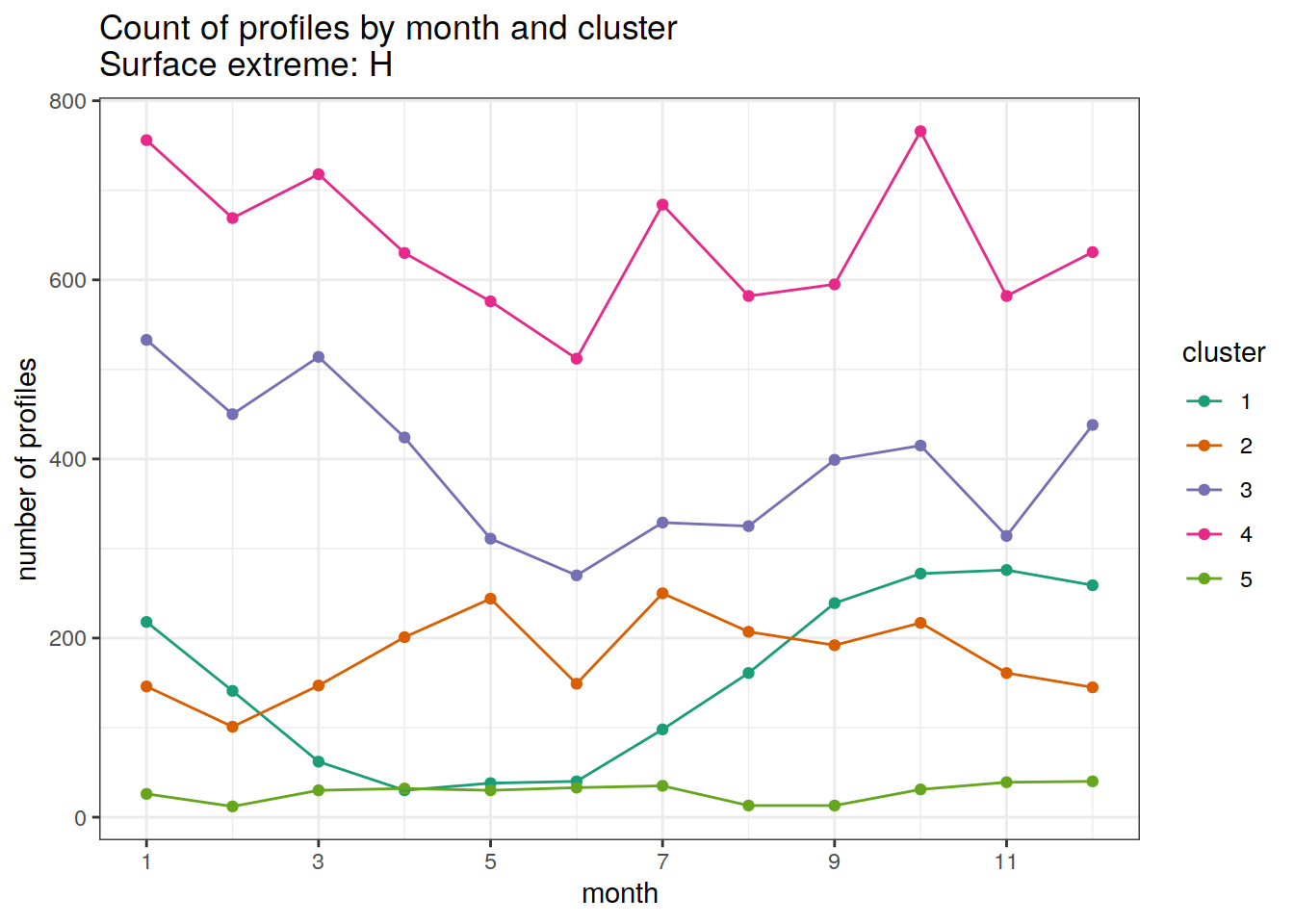
| Version | Author | Date |
|---|---|---|
| 77cc54e | ds2n19 | 2023-11-24 |
Cluster spatial
location of each cluster on map, spatial analysis
# create figure combined
temp_anomaly_cluster_ext %>%
group_split(temp_extreme_order) %>%
map(
~ map +
geom_tile(data = .x,
aes(
x = lon,
y = lat,
fill = cluster
)) +
scale_fill_brewer(palette = 'Dark2') +
labs(
title = paste0(
'cluster spatial distribution \n',
'Surface extreme: ',
unique(.x$temp_extreme)
)
)
)[[1]]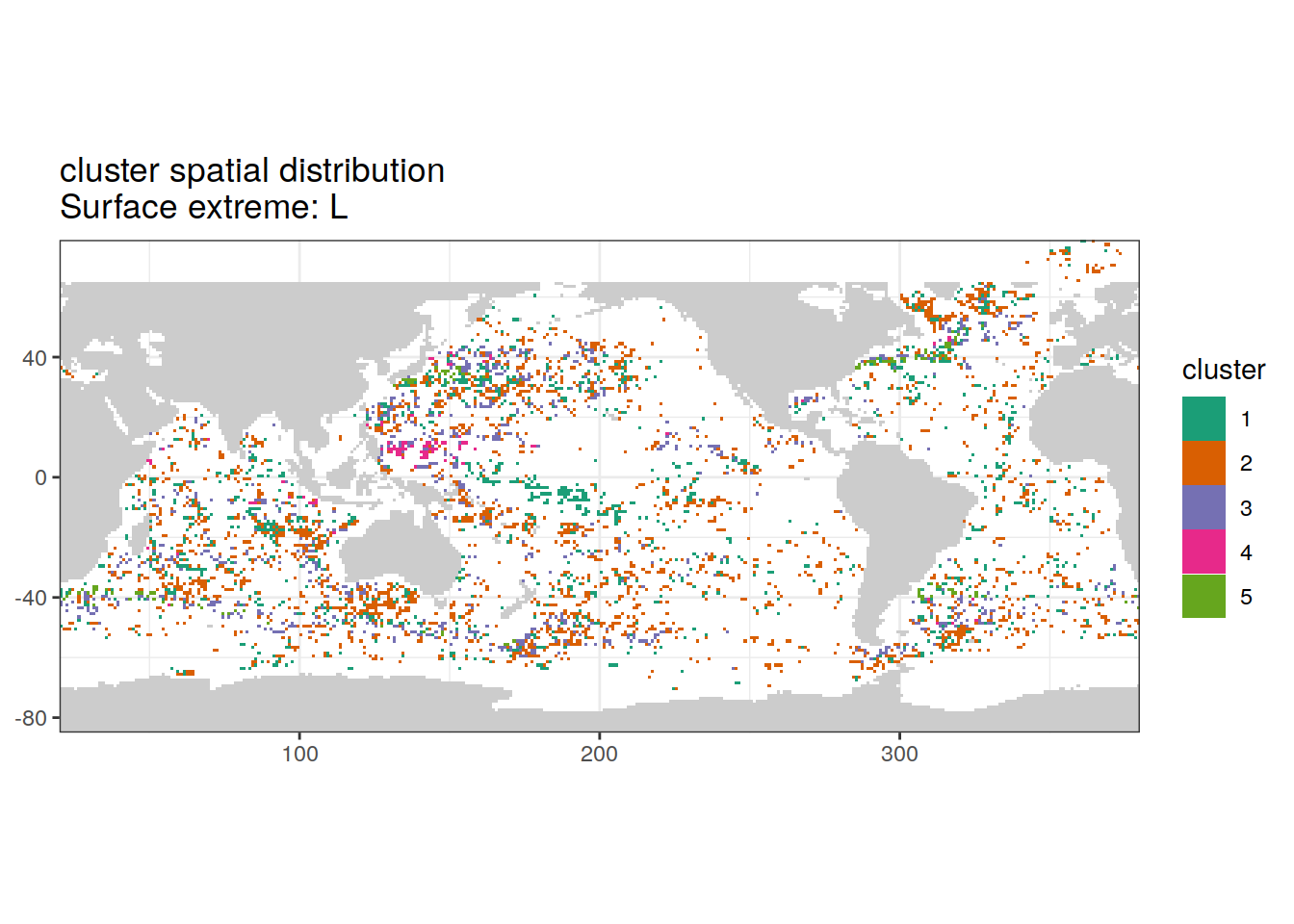
| Version | Author | Date |
|---|---|---|
| 77cc54e | ds2n19 | 2023-11-24 |
[[2]]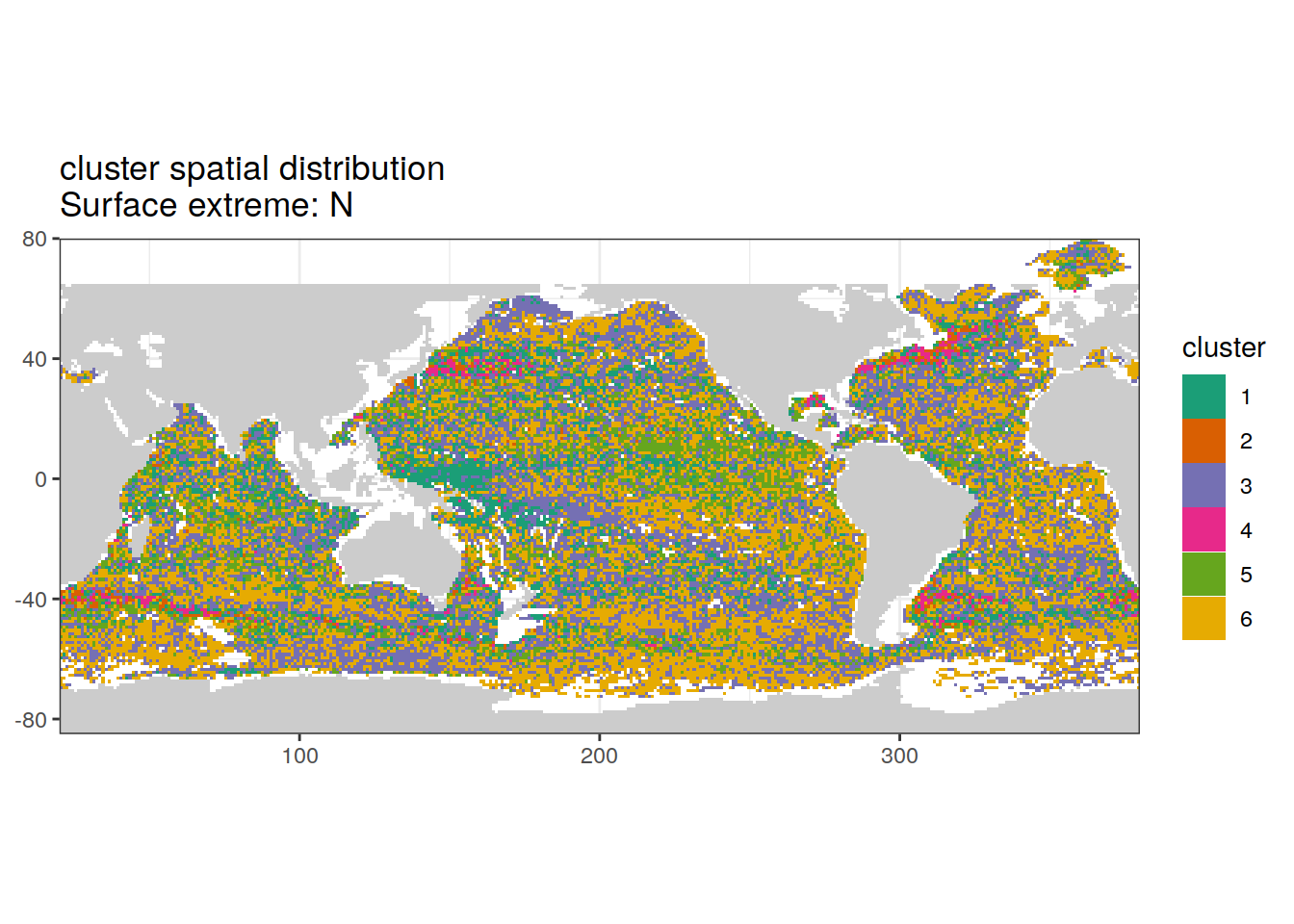
| Version | Author | Date |
|---|---|---|
| 77cc54e | ds2n19 | 2023-11-24 |
[[3]]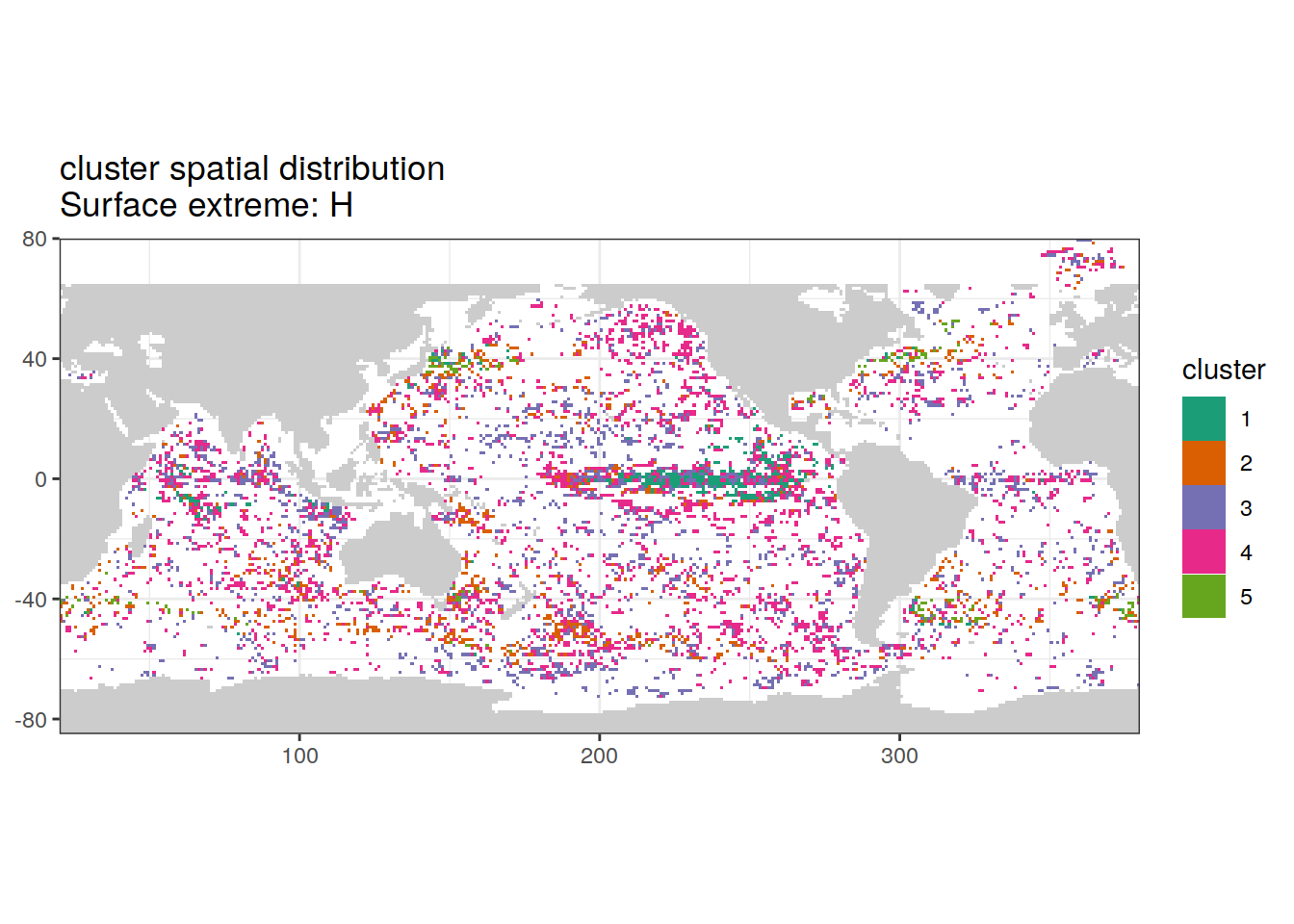
| Version | Author | Date |
|---|---|---|
| 77cc54e | ds2n19 | 2023-11-24 |
Spatial by cluster
location of each cluster on map, spatial analysis
# create figure by cluster
temp_anomaly_cluster_ext %>%
group_split(temp_extreme_order) %>%
map(
~ map +
geom_tile(data = .x,
aes(
x = lon,
y = lat,
fill = cluster
)) +
scale_fill_brewer(palette = 'Dark2') +
facet_wrap( ~ cluster, ncol = 2) +
labs(
title = paste0(
'cluster spatial distribution \n',
'Surface extreme: ',
unique(.x$temp_extreme)
)
)
)[[1]]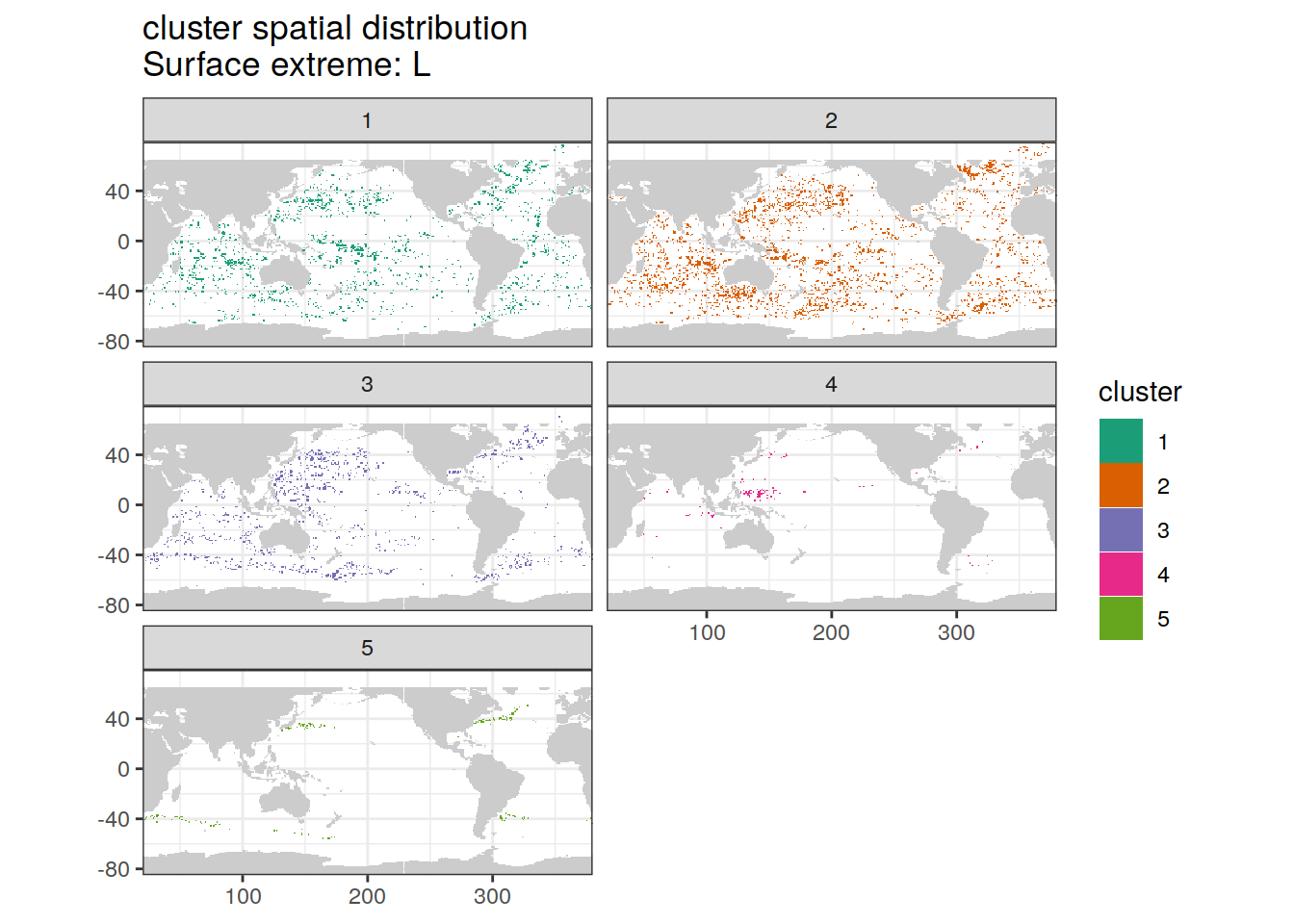
| Version | Author | Date |
|---|---|---|
| 77cc54e | ds2n19 | 2023-11-24 |
[[2]]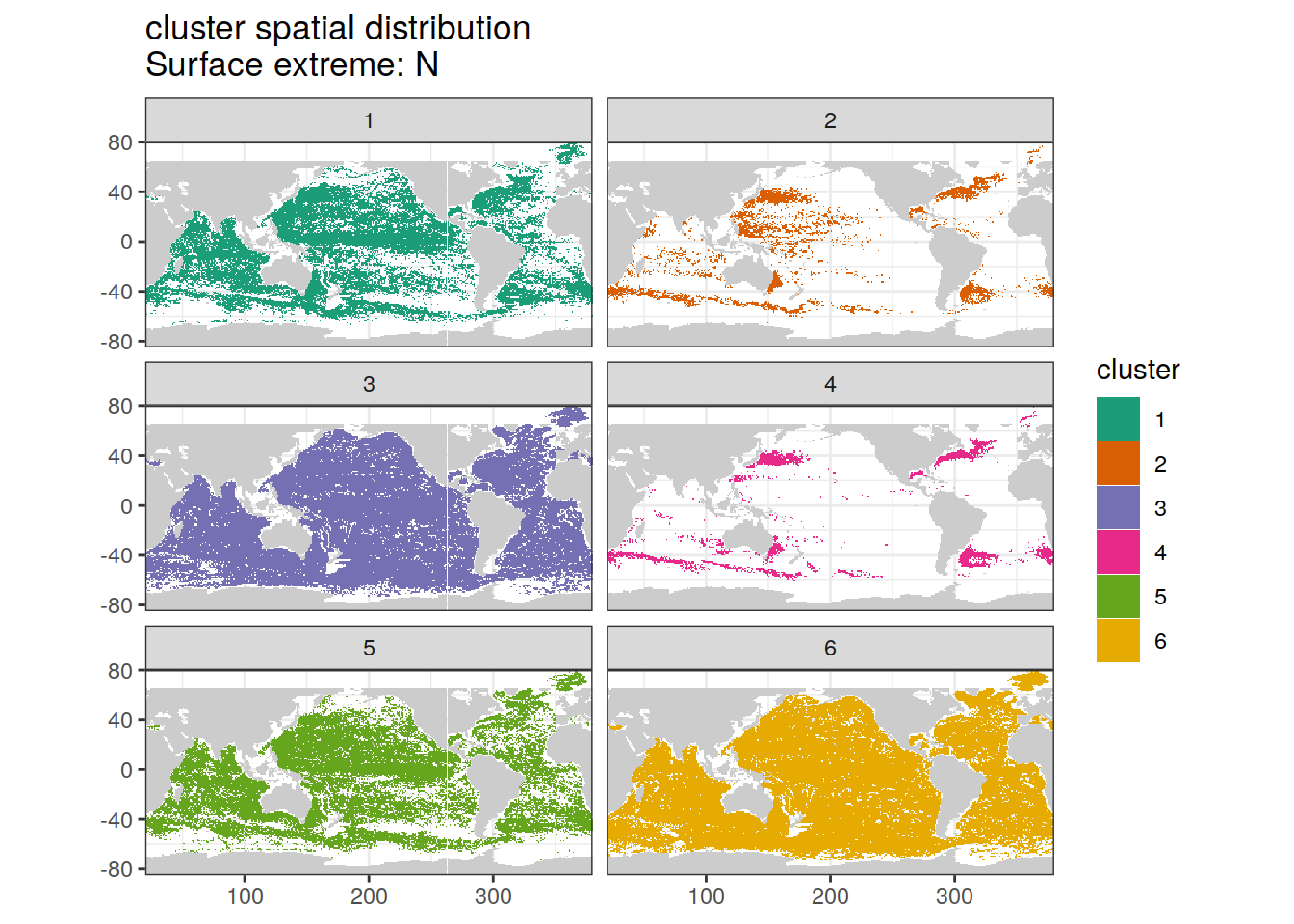
| Version | Author | Date |
|---|---|---|
| 77cc54e | ds2n19 | 2023-11-24 |
[[3]]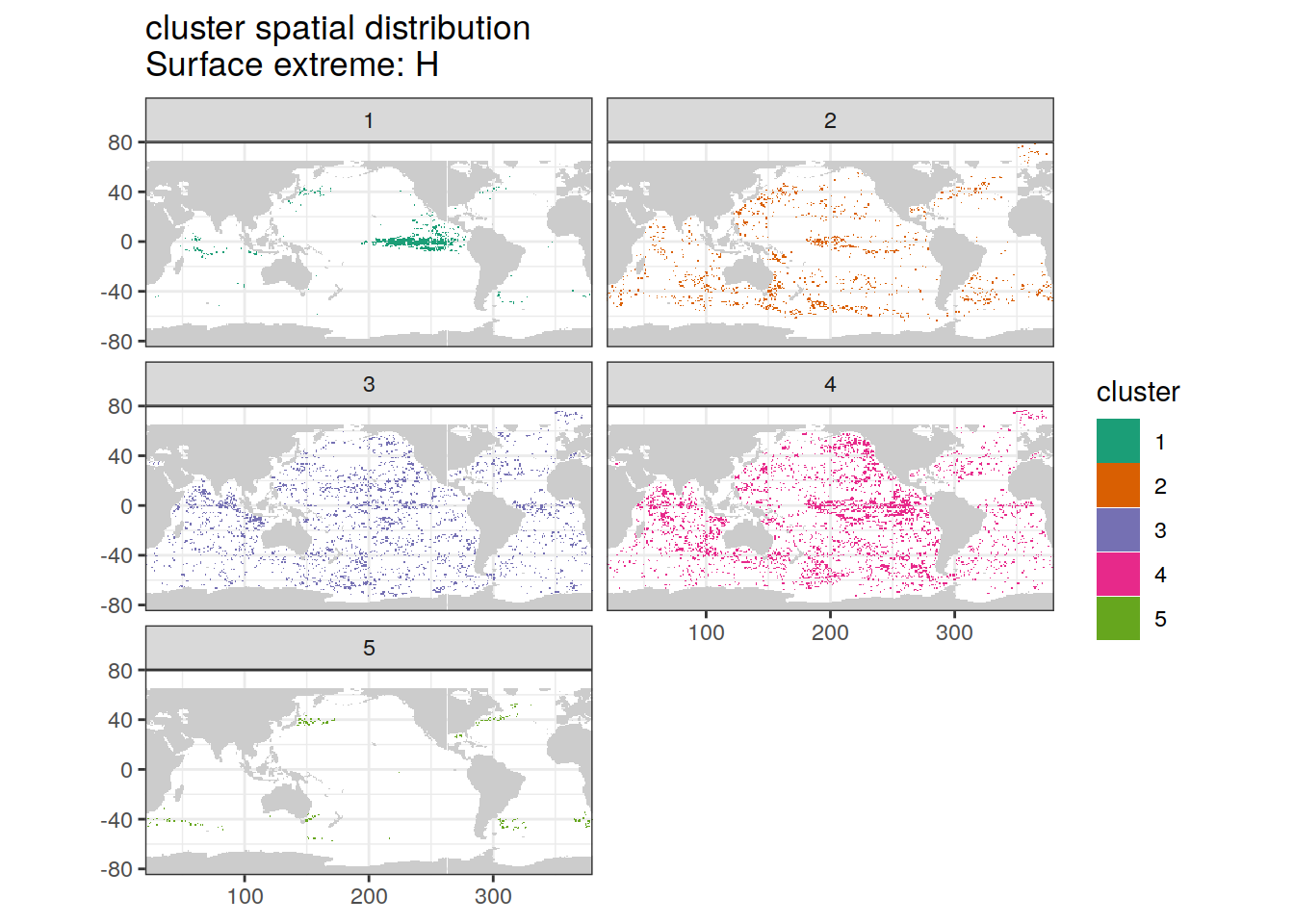
| Version | Author | Date |
|---|---|---|
| 77cc54e | ds2n19 | 2023-11-24 |
Spatial count
location of each cluster on map, spatial analysis
# create figure
temp_anomaly_cluster_ext %>%
group_split(temp_extreme_order) %>%
map(
~ map +
geom_tile(data = .x %>%
count(lat, lon, cluster),
aes(
x = lon,
y = lat,
fill = n
)) +
scale_fill_viridis_c(
option = "cividis",
direction = -1,
trans = "log10"
) +
facet_wrap(~ cluster, ncol = 2) +
labs(
title = paste0(
'cluster spatial distribution \n',
'Surface extreme: ',
unique(.x$temp_extreme)
)
)
)[[1]]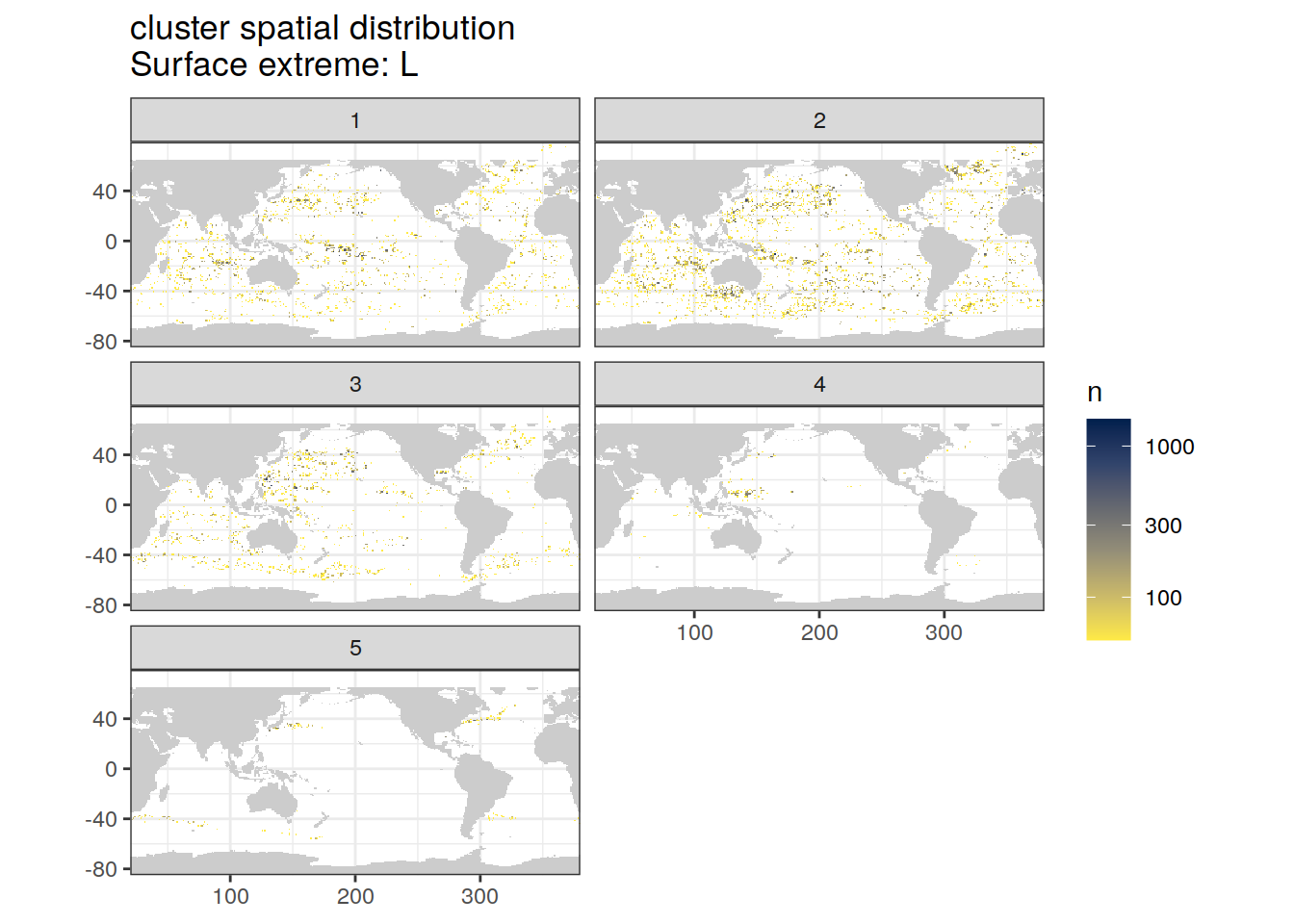
| Version | Author | Date |
|---|---|---|
| 77cc54e | ds2n19 | 2023-11-24 |
[[2]]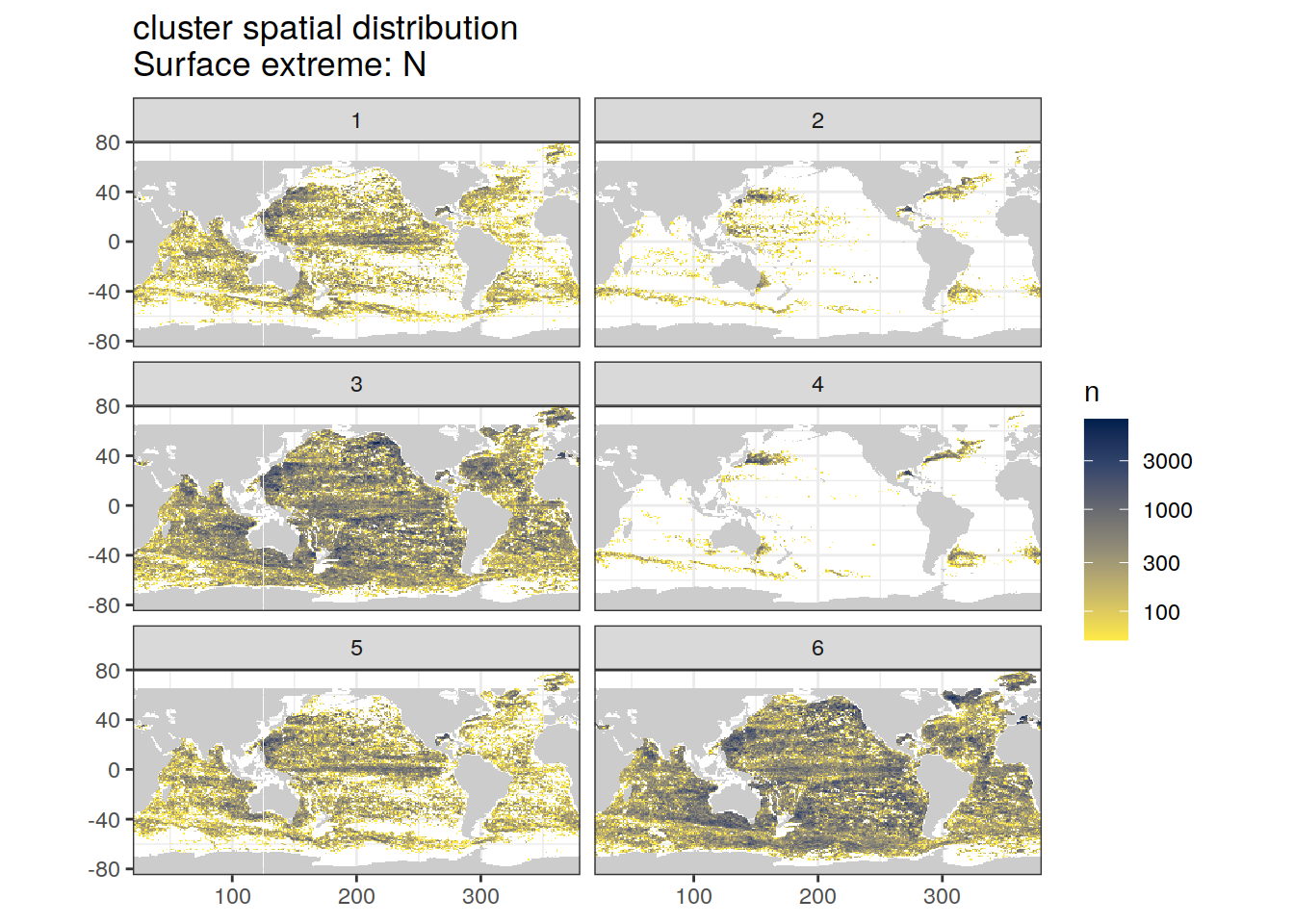
| Version | Author | Date |
|---|---|---|
| 77cc54e | ds2n19 | 2023-11-24 |
[[3]]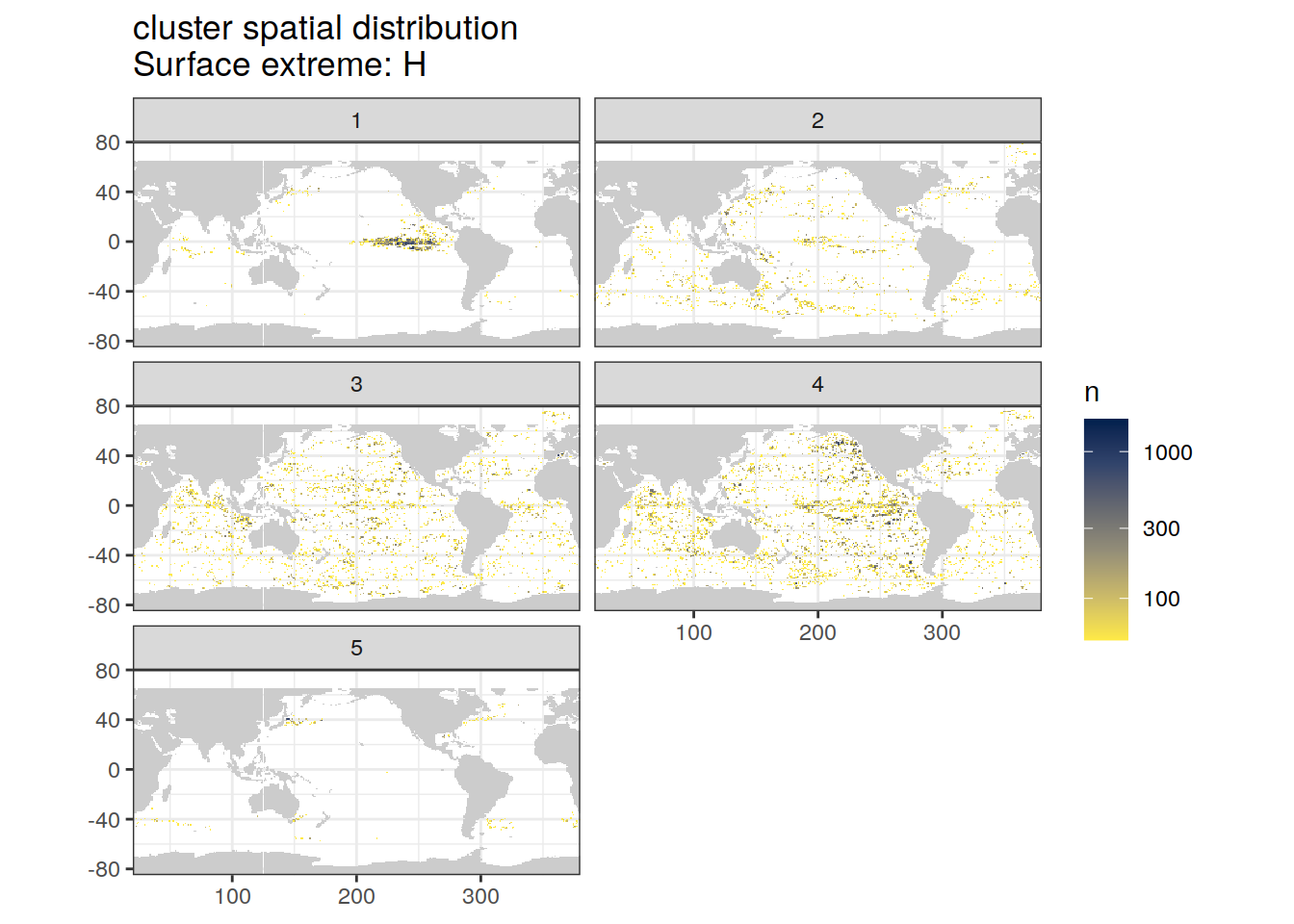
| Version | Author | Date |
|---|---|---|
| 77cc54e | ds2n19 | 2023-11-24 |
sessionInfo()R version 4.2.2 (2022-10-31)
Platform: x86_64-pc-linux-gnu (64-bit)
Running under: openSUSE Leap 15.5
Matrix products: default
BLAS: /usr/local/R-4.2.2/lib64/R/lib/libRblas.so
LAPACK: /usr/local/R-4.2.2/lib64/R/lib/libRlapack.so
locale:
[1] LC_CTYPE=en_US.UTF-8 LC_NUMERIC=C
[3] LC_TIME=en_US.UTF-8 LC_COLLATE=en_US.UTF-8
[5] LC_MONETARY=en_US.UTF-8 LC_MESSAGES=en_US.UTF-8
[7] LC_PAPER=en_US.UTF-8 LC_NAME=C
[9] LC_ADDRESS=C LC_TELEPHONE=C
[11] LC_MEASUREMENT=en_US.UTF-8 LC_IDENTIFICATION=C
attached base packages:
[1] stats graphics grDevices utils datasets methods base
other attached packages:
[1] yardstick_1.2.0 workflowsets_1.0.1 workflows_1.1.3 tune_1.1.2
[5] rsample_1.2.0 recipes_1.0.8 parsnip_1.1.1 modeldata_1.2.0
[9] infer_1.0.5 dials_1.2.0 scales_1.2.1 broom_1.0.5
[13] tidymodels_1.1.1 ggpmisc_0.5.4-1 ggpp_0.5.5 ggforce_0.4.1
[17] gsw_1.1-1 gridExtra_2.3 lubridate_1.9.0 timechange_0.1.1
[21] argodata_0.1.0 forcats_0.5.2 stringr_1.5.0 dplyr_1.1.3
[25] purrr_1.0.2 readr_2.1.3 tidyr_1.3.0 tibble_3.2.1
[29] ggplot2_3.4.4 tidyverse_1.3.2
loaded via a namespace (and not attached):
[1] googledrive_2.0.0 colorspace_2.0-3 ellipsis_0.3.2
[4] class_7.3-20 rprojroot_2.0.3 fs_1.5.2
[7] rstudioapi_0.15.0 furrr_0.3.1 listenv_0.8.0
[10] farver_2.1.1 MatrixModels_0.5-1 prodlim_2019.11.13
[13] fansi_1.0.3 xml2_1.3.3 codetools_0.2-18
[16] splines_4.2.2 cachem_1.0.6 knitr_1.41
[19] polyclip_1.10-4 polynom_1.4-1 jsonlite_1.8.3
[22] workflowr_1.7.0 dbplyr_2.2.1 compiler_4.2.2
[25] httr_1.4.4 backports_1.4.1 assertthat_0.2.1
[28] Matrix_1.5-3 fastmap_1.1.0 gargle_1.2.1
[31] cli_3.6.1 later_1.3.0 tweenr_2.0.2
[34] htmltools_0.5.3 quantreg_5.94 tools_4.2.2
[37] gtable_0.3.1 glue_1.6.2 Rcpp_1.0.10
[40] cellranger_1.1.0 jquerylib_0.1.4 RNetCDF_2.6-1
[43] DiceDesign_1.9 vctrs_0.6.4 iterators_1.0.14
[46] timeDate_4021.106 xfun_0.35 gower_1.0.0
[49] globals_0.16.2 rvest_1.0.3 lifecycle_1.0.3
[52] googlesheets4_1.0.1 future_1.29.0 MASS_7.3-58.1
[55] ipred_0.9-13 hms_1.1.2 promises_1.2.0.1
[58] parallel_4.2.2 SparseM_1.81 RColorBrewer_1.1-3
[61] yaml_2.3.6 sass_0.4.4 rpart_4.1.19
[64] stringi_1.7.8 highr_0.9 foreach_1.5.2
[67] lhs_1.1.6 hardhat_1.3.0 lava_1.7.0
[70] rlang_1.1.1 pkgconfig_2.0.3 evaluate_0.18
[73] lattice_0.20-45 labeling_0.4.2 tidyselect_1.2.0
[76] parallelly_1.32.1 magrittr_2.0.3 R6_2.5.1
[79] generics_0.1.3 DBI_1.1.3 pillar_1.9.0
[82] haven_2.5.1 whisker_0.4 withr_2.5.0
[85] survival_3.4-0 nnet_7.3-18 future.apply_1.10.0
[88] modelr_0.1.10 crayon_1.5.2 utf8_1.2.2
[91] tzdb_0.3.0 rmarkdown_2.18 grid_4.2.2
[94] readxl_1.4.1 git2r_0.30.1 reprex_2.0.2
[97] digest_0.6.30 httpuv_1.6.6 GPfit_1.0-8
[100] munsell_0.5.0 viridisLite_0.4.1 bslib_0.4.1